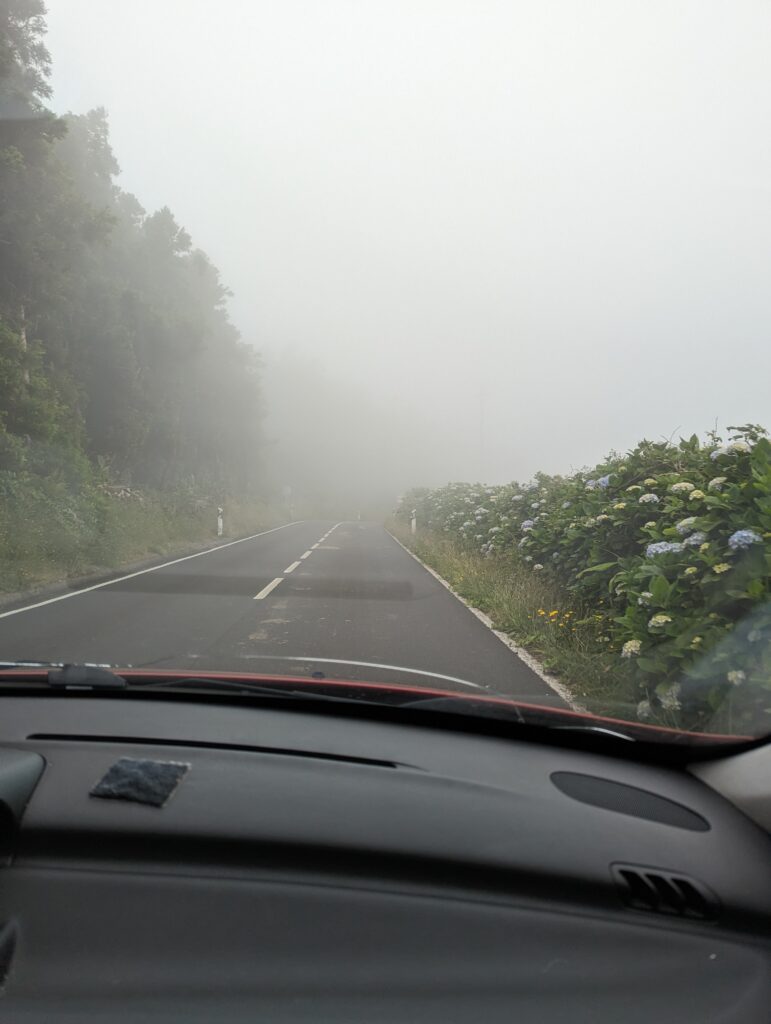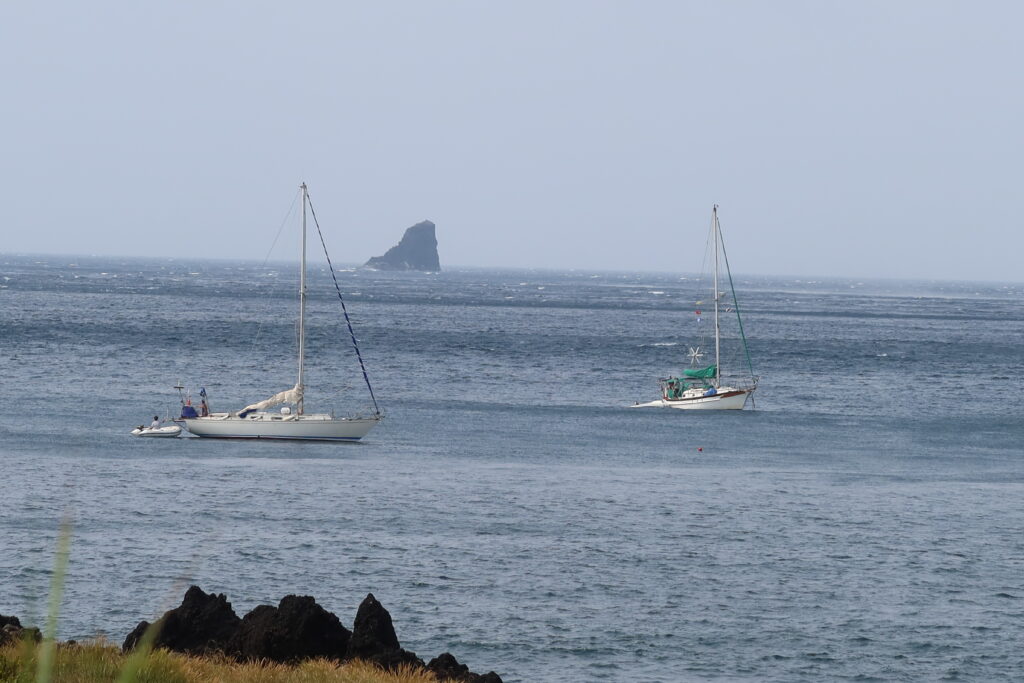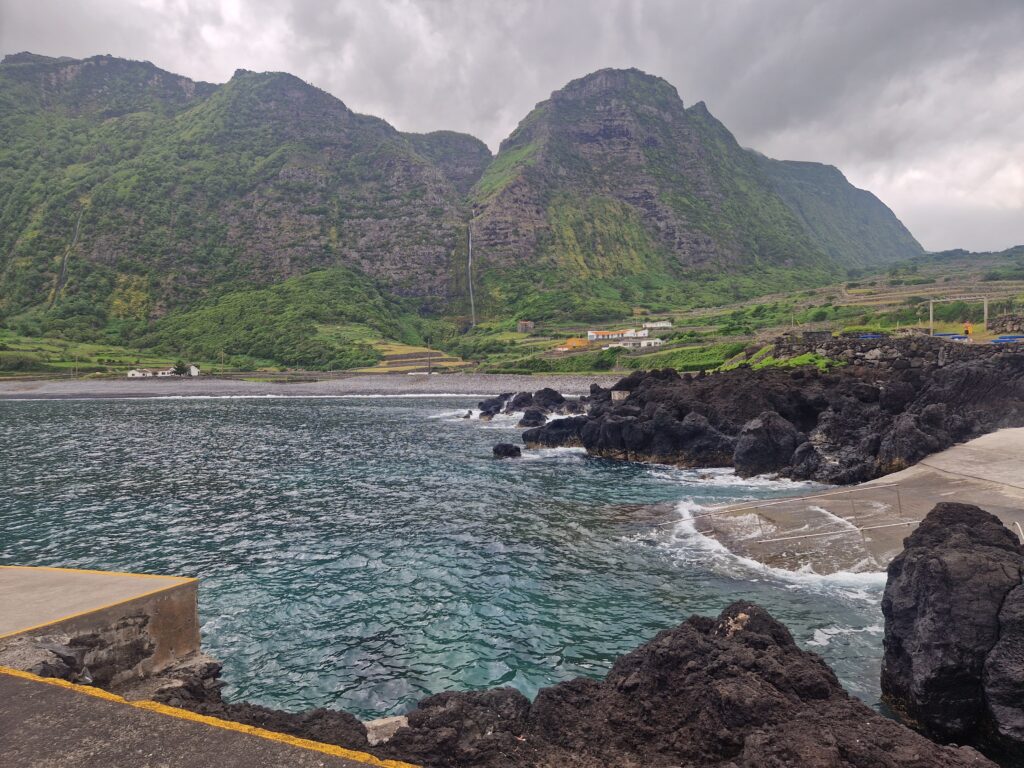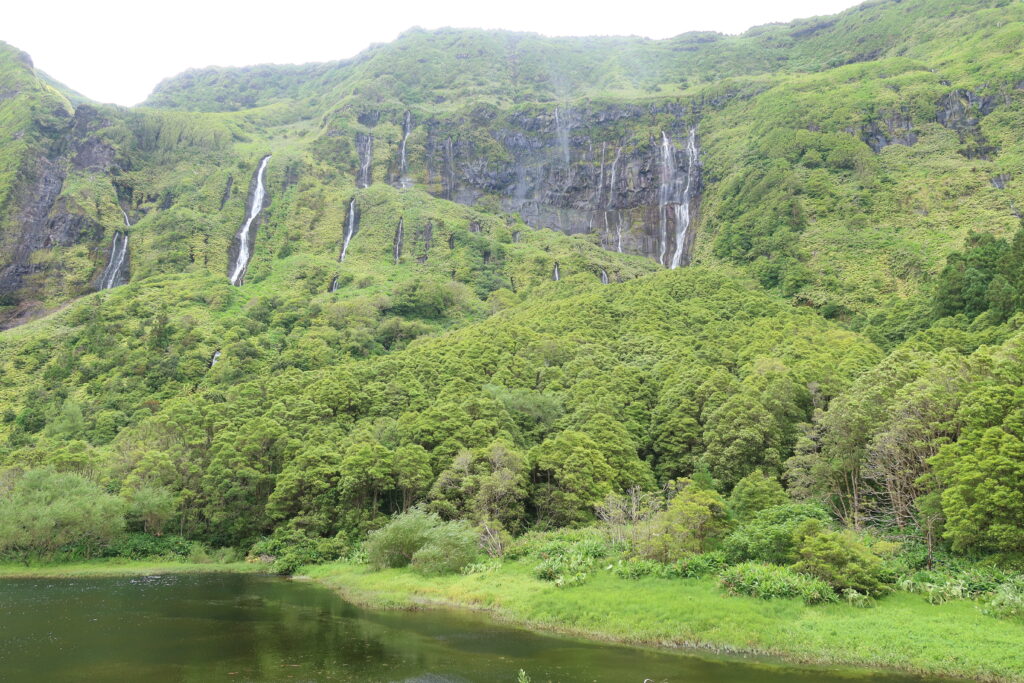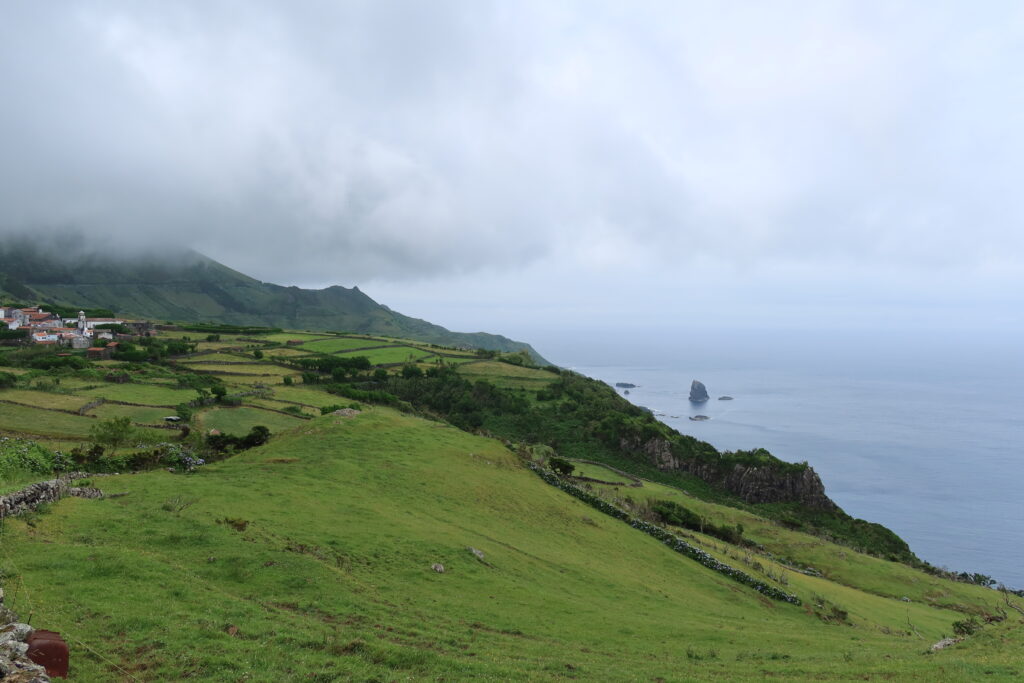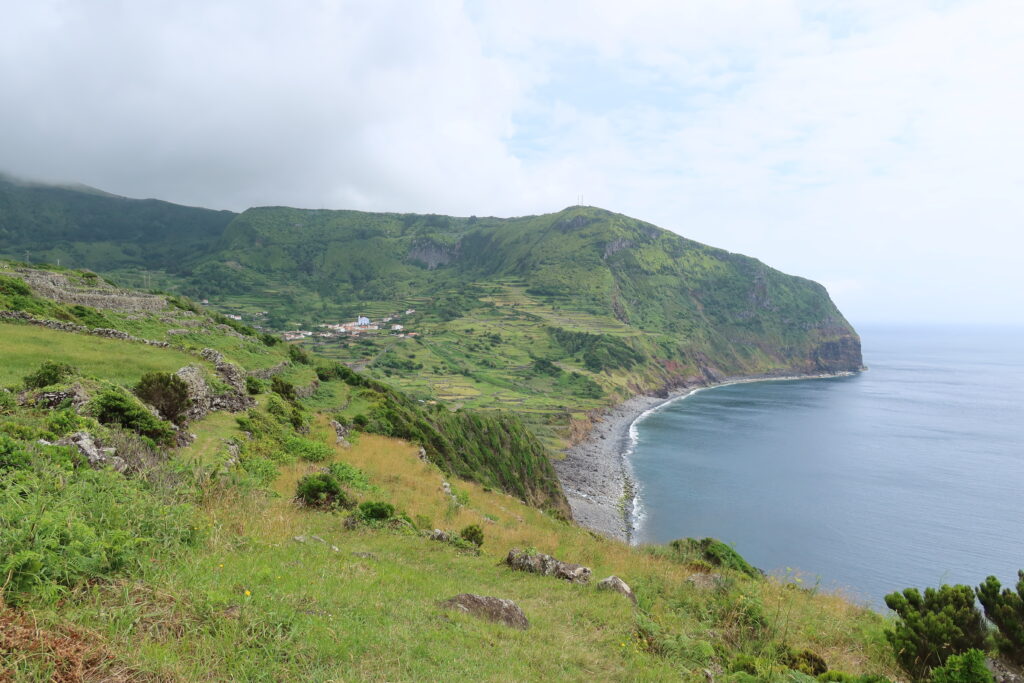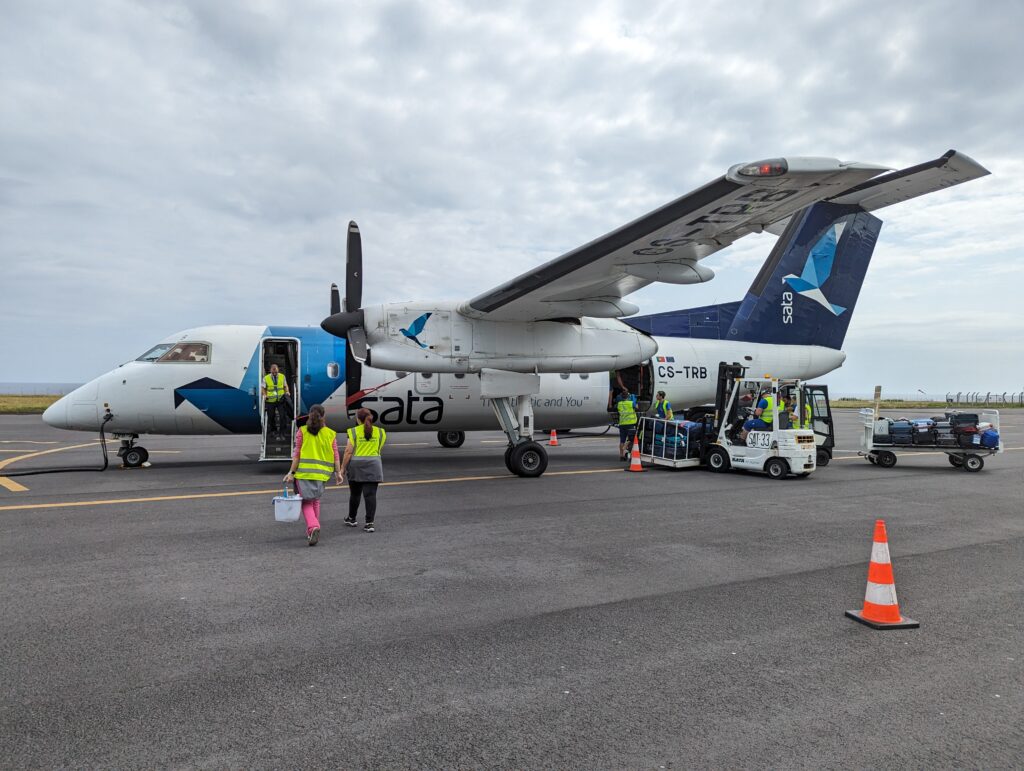Flores, Azores – June 2023 (by Luke, June/July 2024)
From Sao Miguel we flew to the island of Flores where we had four remarkable days planned. From everything that we had seen prior to visiting it looked like Flores was going to be amazing. We were both so excited to see the unspoilt beauty it had to offer.
day 5 – Flores (28/06/23)
We were met at the airport by Stefano, the owner of the Argonauta guest house that we were staying in. He collected us in his personal car and started with an apology for the food shopping in the footwell. There ‘had been a delivery earlier in the day and you have to get fresh produce when it is available’. From Santa Cruz das Flores we drove across the width of the island towards Fajã Grande. The weather was foggy and really windy as we drove across the highest part of the island.
We stopped at Miradouro do Portal so Stefano could show us where we were going and the stunning beauty of the area. From here we saw Fajã Grande in the distance. Stefano explained that ‘fajã’ is a local name for the land formed when lava flowed into the sea.
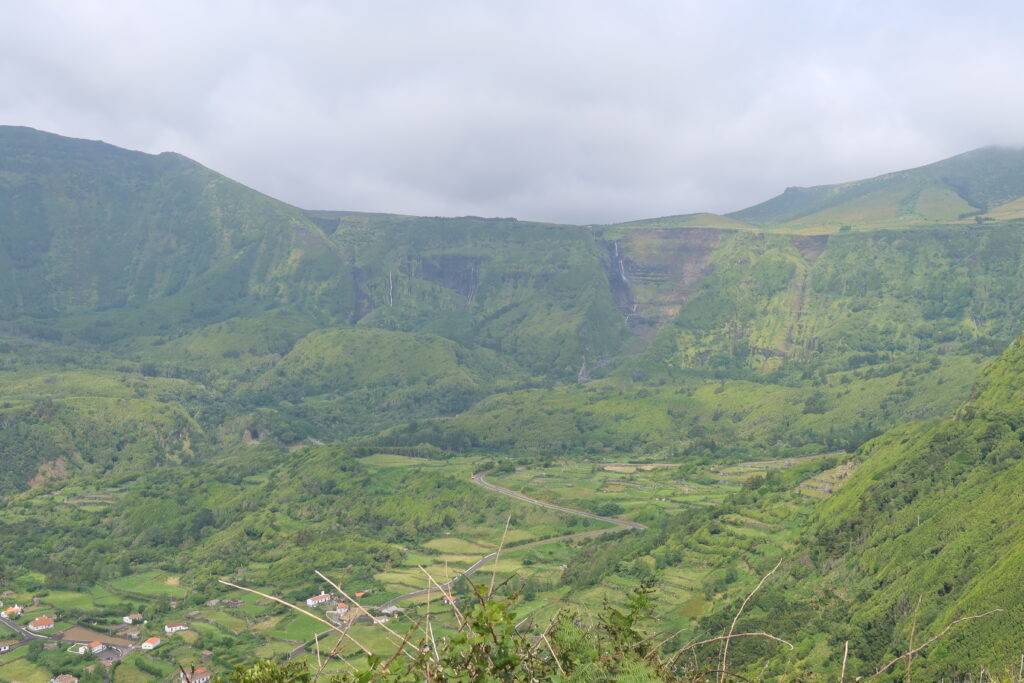
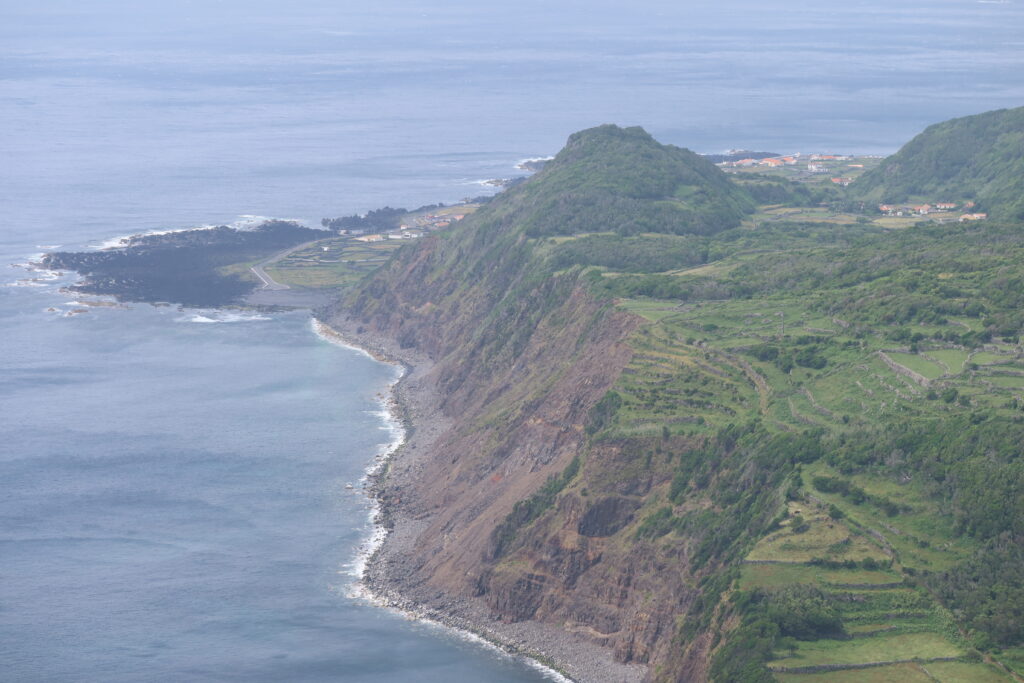
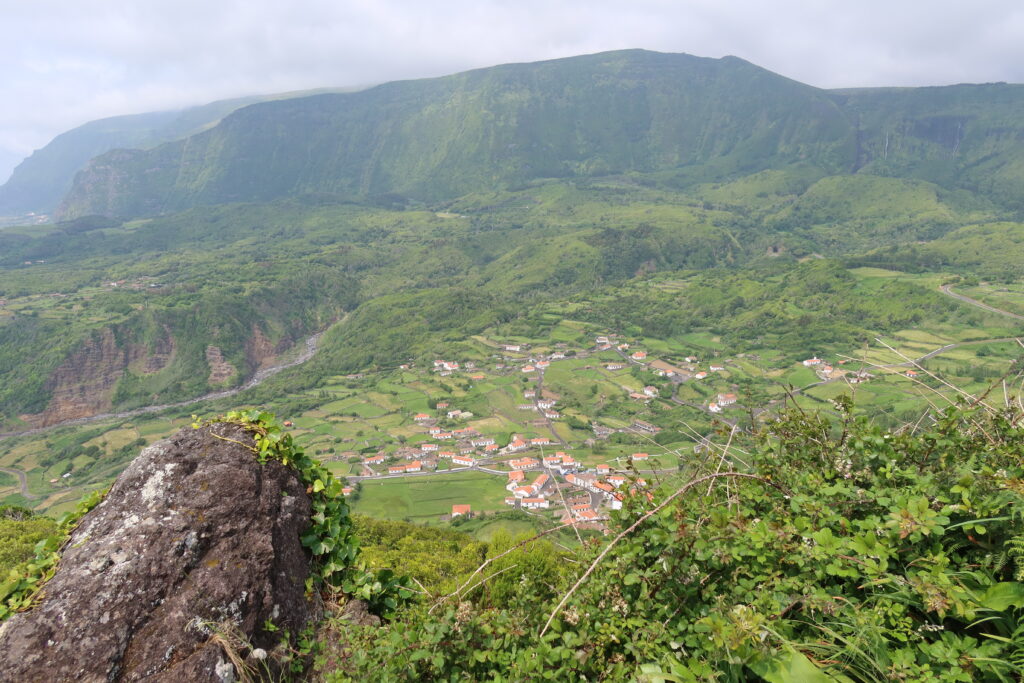

When we arrived Stefano showed us around Argonauta with so much pride and we carried our suitcases up to the top floor (again!). We were staying in the ‘northwest’ suite, one of 2 suites in the converted attic of the guest house. It was a massive room, with space for a seating area, a table and chairs and even an enclosed balcony. After unpacking some of our stuff we got changed and went for a walk.
The village of Fajã Grande was never busy (in 2021 there were 220 residents) but it was nice to walk through on the way to finding Cascata do Poço do Bacalhau. This waterfall should drop around 90m to a small pool. It wasn’t when we were there due to the wind blowing it the wrong way!
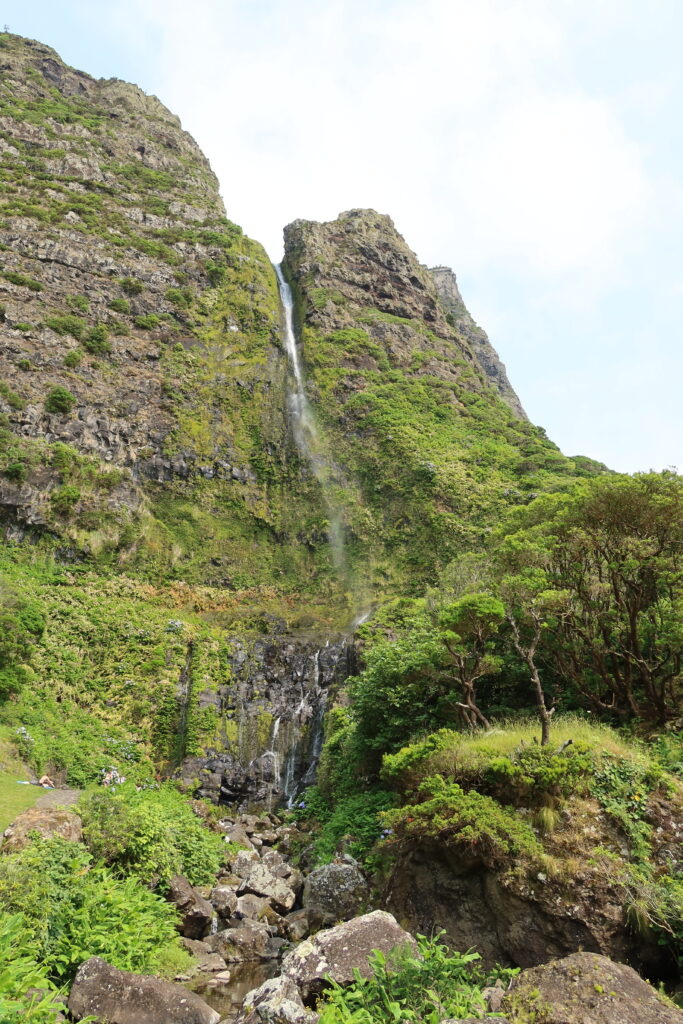
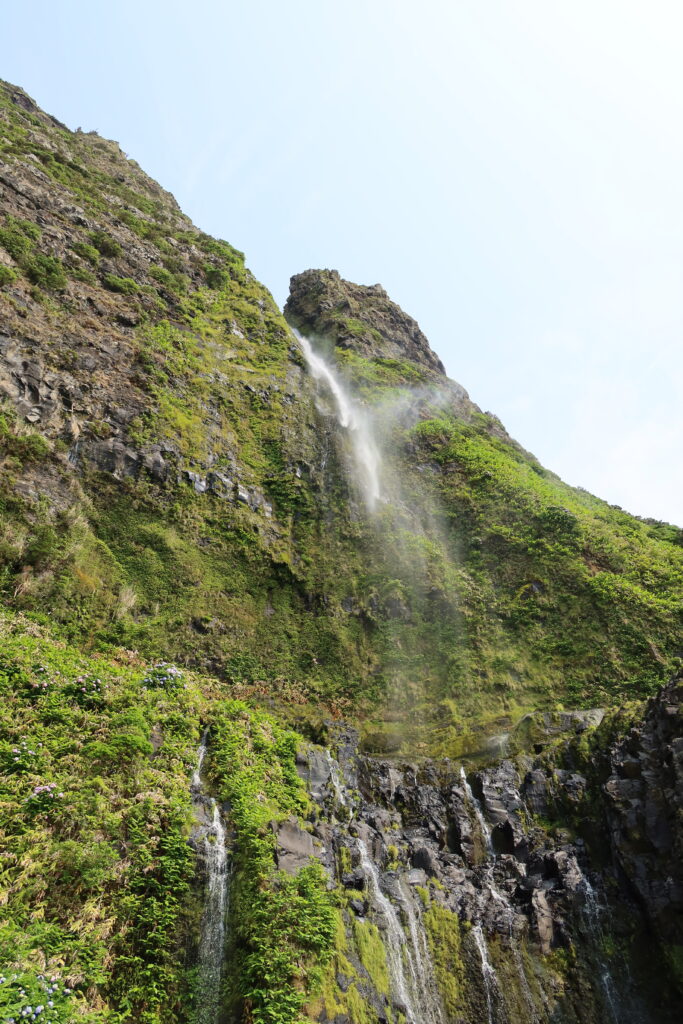
Wandering along towards the coast we saw a stunning house between the waterfall and the sea. While I was thinking of how we could buy it we popped into Barraca Q’abana for a beer and pastel de nata. Barraca Q’abana is a bit of everything. It’s a bar, restaurant, coffee shop which seemed to be used as a meeting place for locals and tourists alike. There were also a number of cats and dogs that hung around here. We enjoyed meeting the dogs and watching their rivalry with the cats play out!
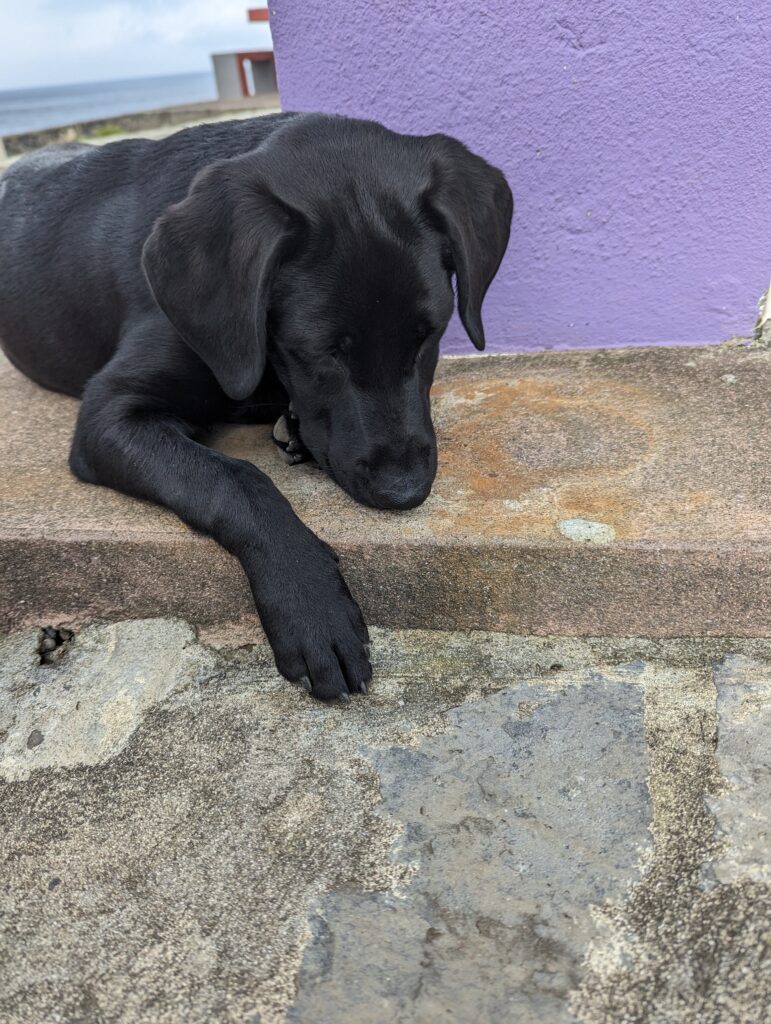
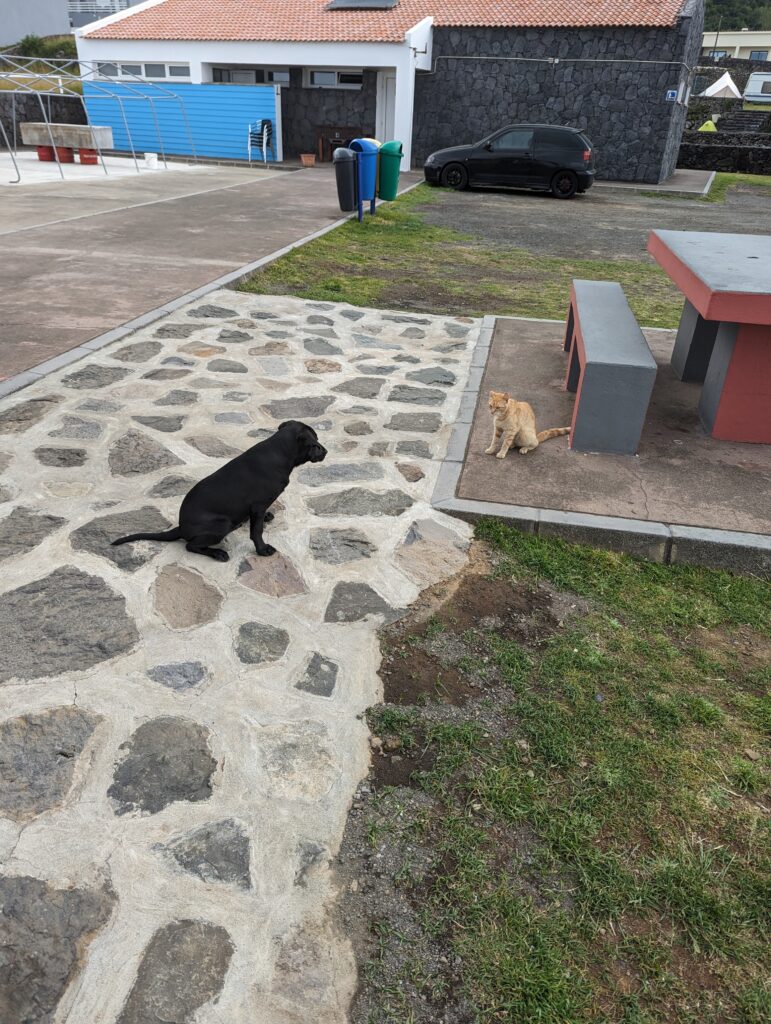
They don’t make anything of it but Barraca Q’abana also must be the westernmost venue in Europe that you can eat or drink! Just off the coast (to the north of Fajã Grande) is a small islet that is the official Westernmost point of Europe*. We walked across the faja to get as close to the sea as possible and be as far west as anyone could be without going to the islet itself!
*A little note for my sanity. I’d personally call Flores the easternmost part of Northern America due to the continental shelf that it is on, however for the collection of places that make up ‘Europe’ as a grouping of countries it is the westernmost point!
While we were trying to decide what continent was where we walked back to Argonauta to change. Dinner tonight was at Papadiamandis Restaurante-Bar, one of the 3 options for food in the evening in Fajã Grande.
It was quite a warm evening so we had the roof windows open while we slept. The village was so quiet apart from a really strange noise which Stefano told us the next morning was from Cory’s Shearwaters. These sea birds nest on cliffs for the purpose of breeding. They hunt fish and molluscs which they bring back to the nest for their young, mainly during the night.
Cory’s Shearwaters are quiet while at sea then are anything but when in/around their nests. The noise was non-stop! There’s no real way of describing their noise. It’s like a cross between gurgling and warbling. It’s similar to the sound of a noise making plastic toy (that I also can’t describe very well) that I used to have as a kid, you turned it from side to side and it made a noise as whatever was inside moved from one end to the other.
Stefano was part of the local Cory’s Shearwater rescue team that saves the birds when they fall off the cliffs. The young birds are left to it by their parents from 3 months old and this can lead to problems. It is thought that they navigate their way to the ocean using the stars or the moon but sometimes they can become disorientated by artificial lights. If this happens there is a chance that they may ‘crash land’ and once they are on the ground they are unable to get themselves back to flying again. Stefano and his fellow volunteers would go out and gather these grounded birds, check them over and then release them from height so that they were able to utilise the wind (and the fall) to fly again. Stefano is a remarkable, selfless man!
day 6 – island tour
Our breakfast was freshly made and served by Stefano and his brother. They were like chalk and cheese. Stefano was the outgoing one, his brother was very much in the background making things tick. The items available for breakfast constantly change dependent on what food is available on the island.
After breakfast we were collected for a small group island tour. The weather wasn’t great at all and we were told that we’d be unlikely to see much when we got to the higher altitude parts of the island. We were ready by this point so there was no chance we weren’t going to a least try. It turns out that this was well worth doing!
The tour started in Fajã Grande with Cascata do Poço do Bacalhau. We tried to act all surprised and like we hadn’t seen it the day before. The weather was totally different at this point and the water was managing to get to the pool at the bottom without being interrupted by the wind.
Leaving the village we continued to the multiple waterfalls falling into the lake at Poço da Alagoinha. This is an iconic sight in Flores, and the Azores as a whole. Waterfalls do seem like natures way of showing off so when you have multiple waterfalls in one place its even better! Here it seemed like the whole cliff was alive with tumbling water. The surrounding area was another place that felt like it was from the set of Jurassic Park too!
Also known as Poço da Ribeira do Ferreiro or Lagoa das Patas (‘duck lagoon’), the area is a haven for wildlife and is in a protected reserve. I’ve never been anywhere like it before. It was stunning looking, amazingly peaceful and immediately made you feel so close to nature!
We walked down the 800m or so forest path and back to the minivan to set off for Miradouro Rocha dos Bordões. Here we saw somewhat cloudy views of the vertical basalt columns.
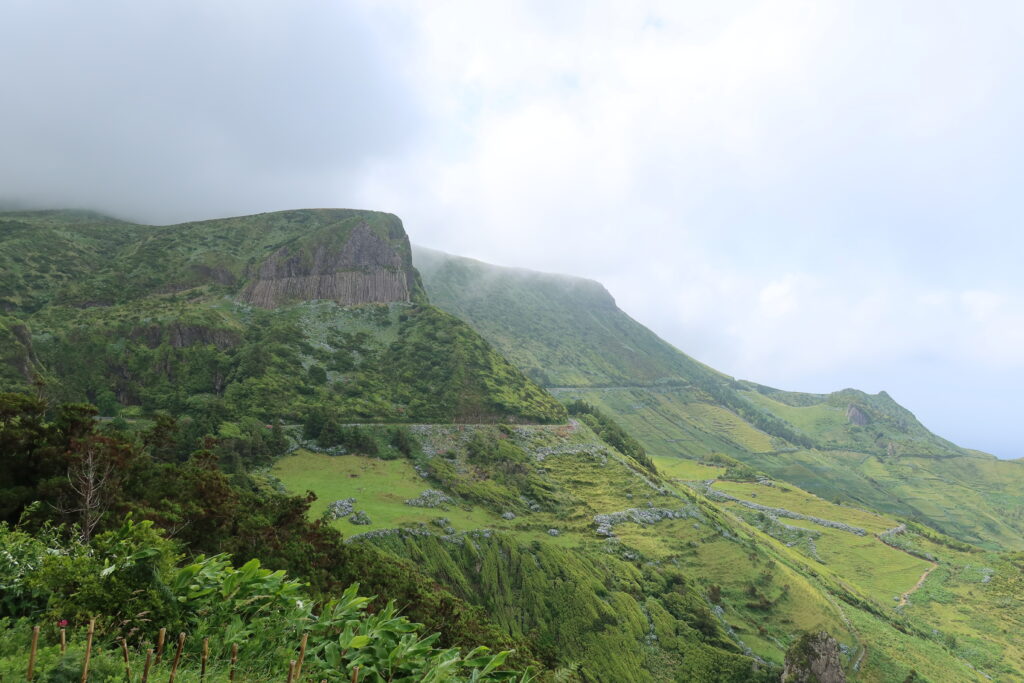
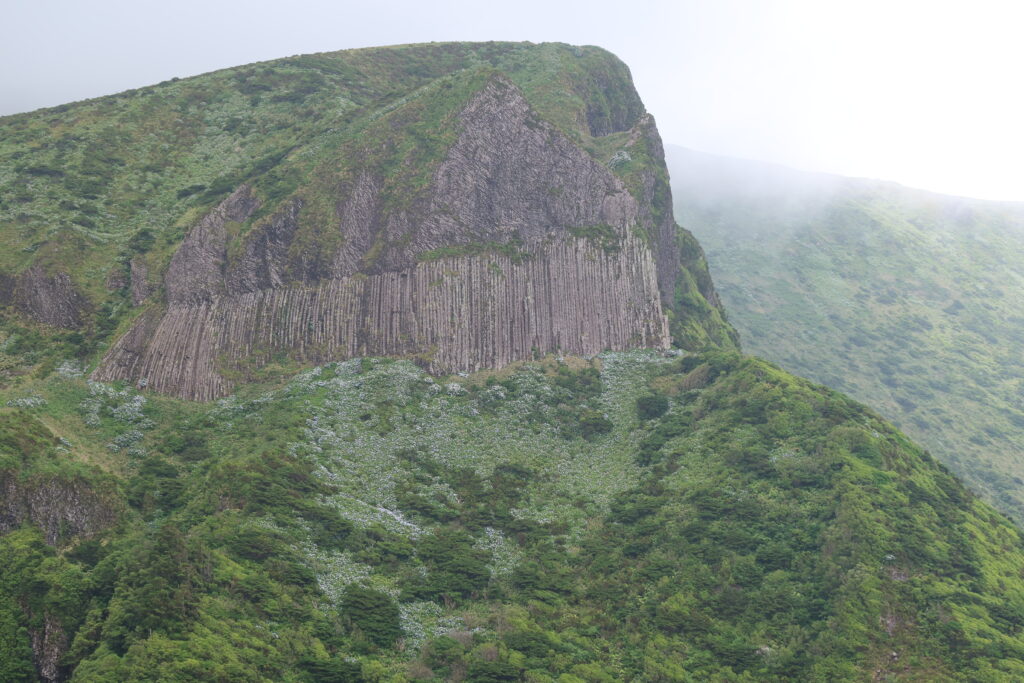
Next we travelled across the island and saw the Sete Lagoas (seven lagoons). These are Lagoas Branca (white), Seca (dry), Negra (black), Comprida (long), Lomba, Rasa (shallow) and Funda (deep). The weather wasn’t great but it cleared at each of the lagoons for us to be able to see and get a picture. As captured in the below video, the fast moving cloud added to the drama of the views.
Despite all of these crater lakes there have been no recorded volcanic events on Flores so it is deemed extinct. The eruption that created Lagoa Seca is thought to have happened around 3,000 years ago and produced the lava flow that ran northwest and created Fajã Grande.
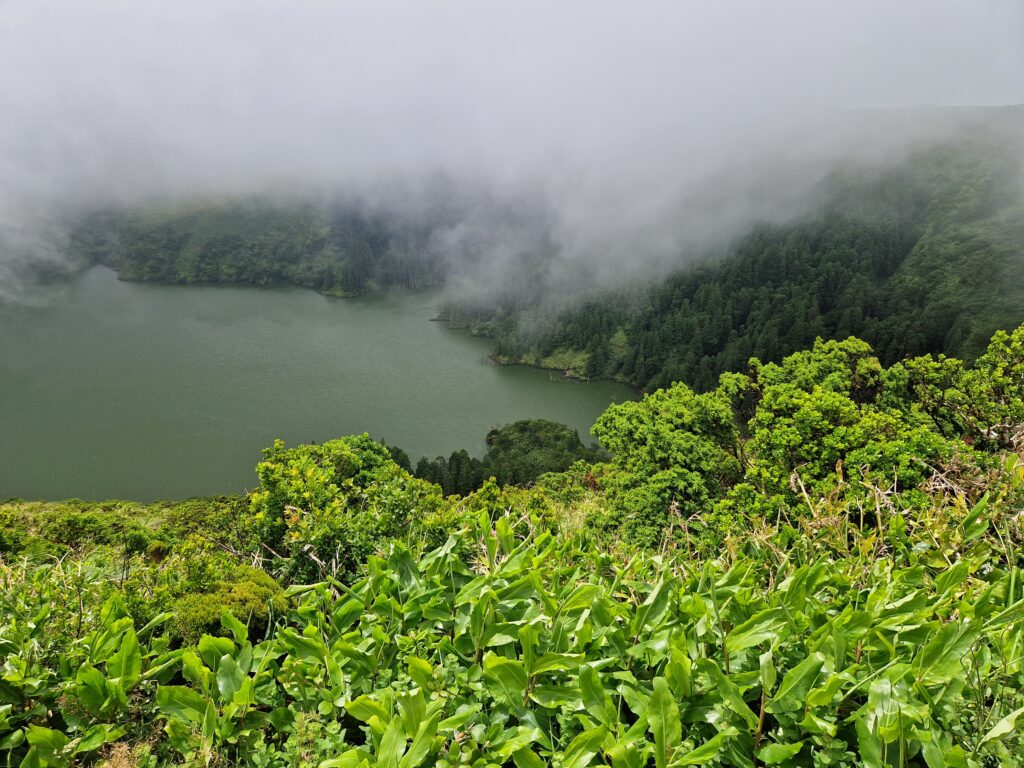
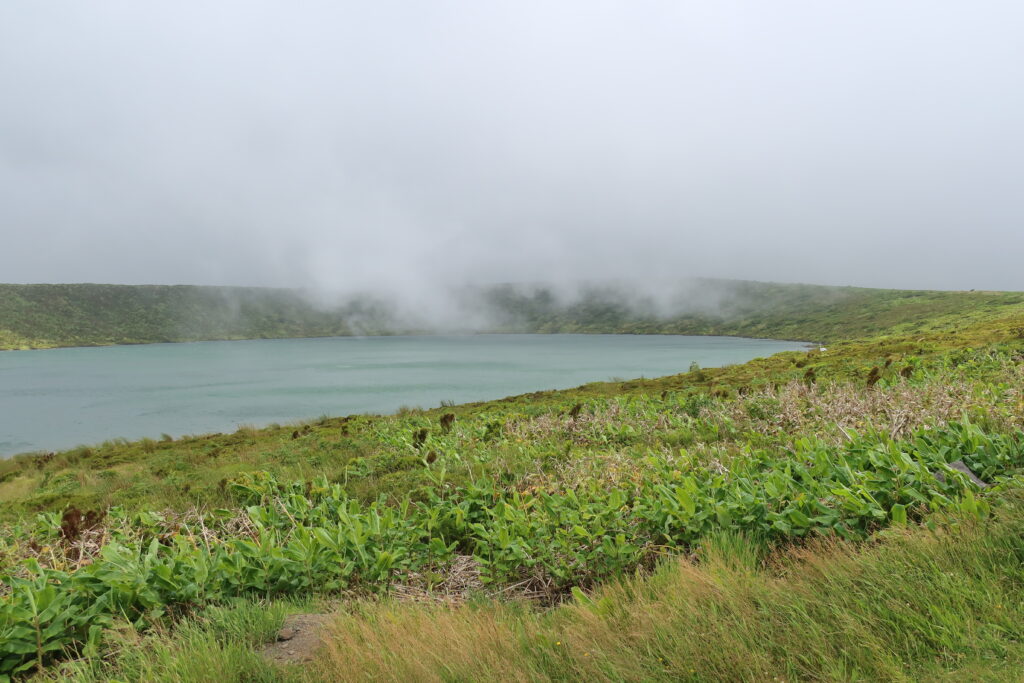
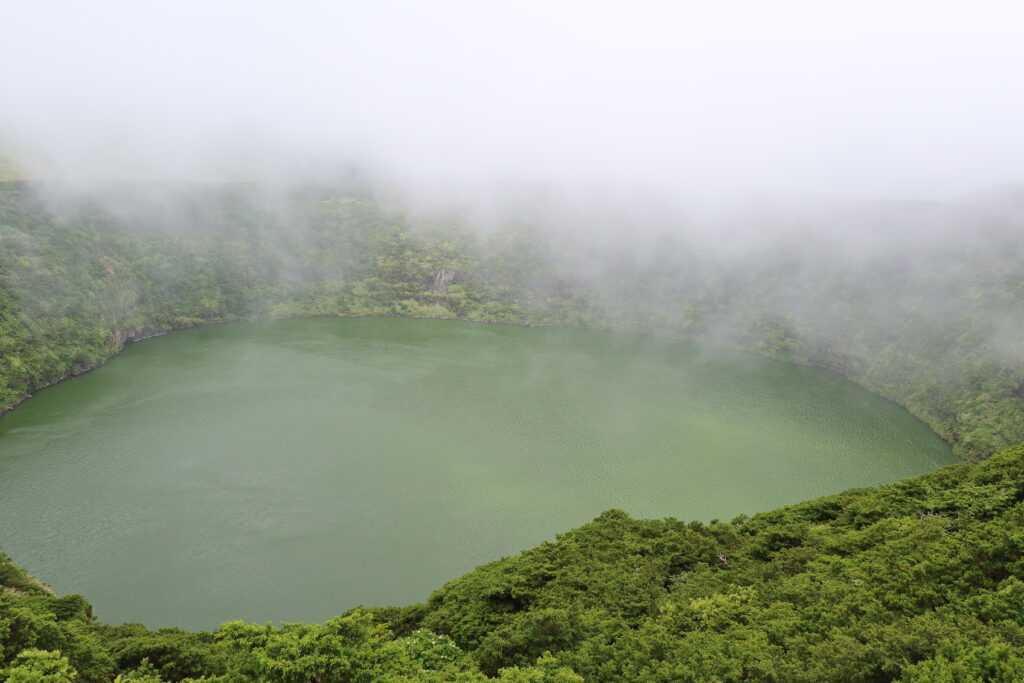
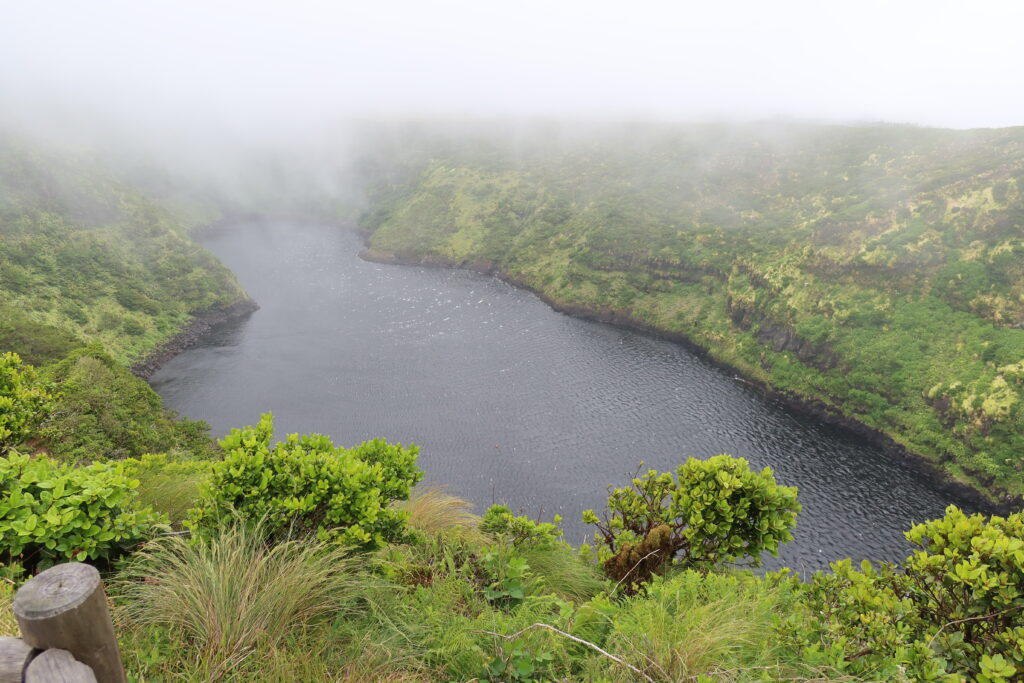
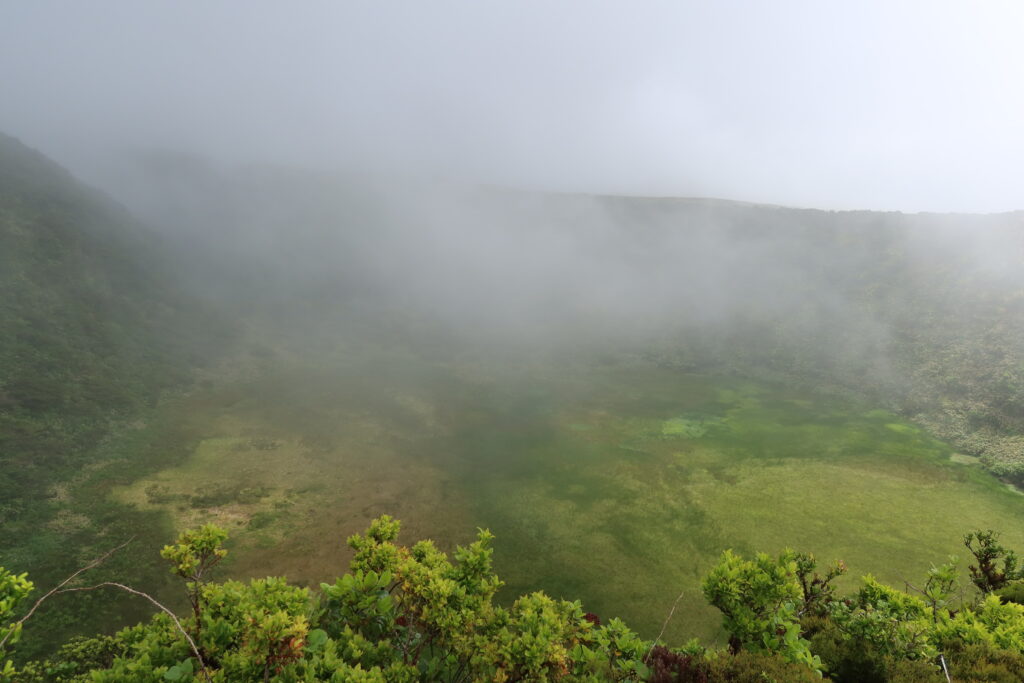
We stopped for a late lunch in the capital Santa Crus Das Flores then continued up the east coast. Our first stop this afternoon was to see Baía de Alagoa. We viewed it from above at Parque de Alagoa and then from sea level. Getting close to the sea stacks and the ‘black’ beach was well worth the effort that it took. It was such a dramatic part of the coast!
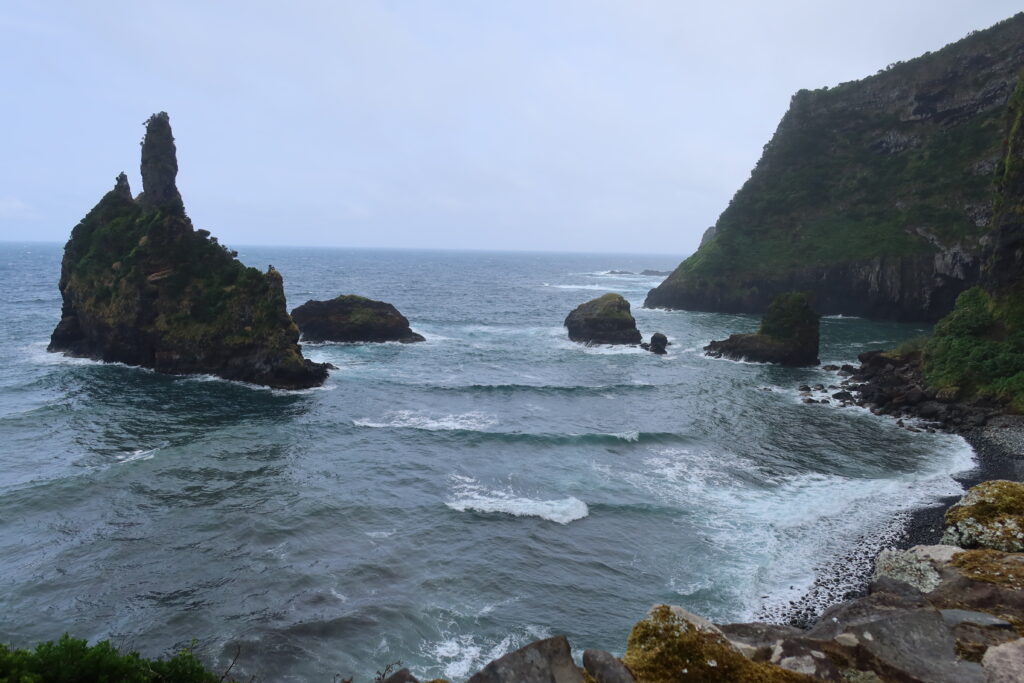
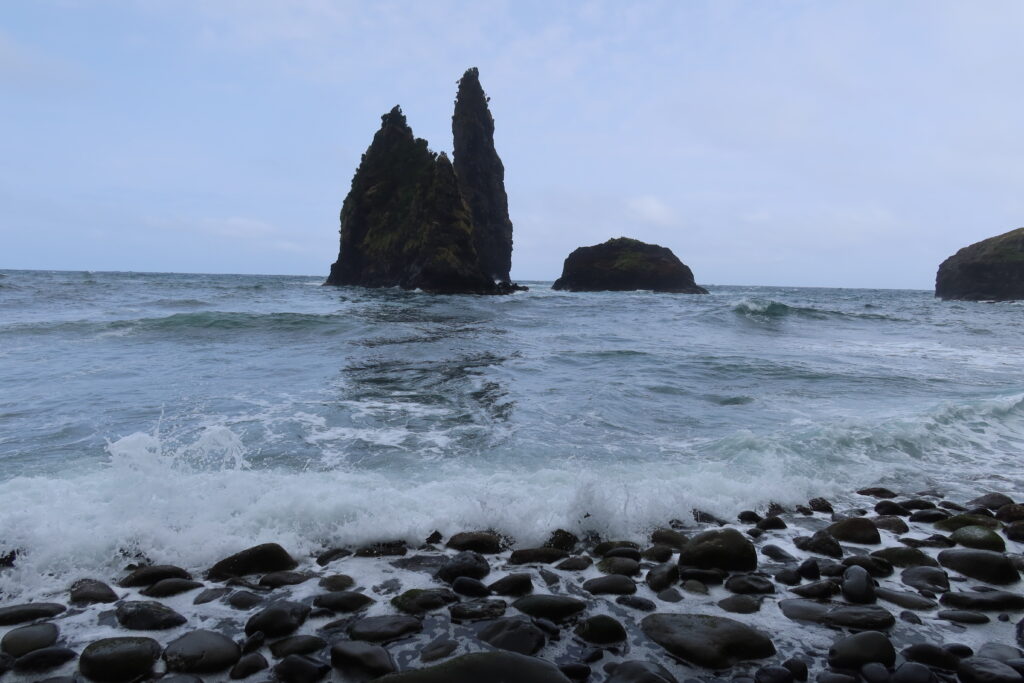
Another stop was at a house with traditional items in it. I liked the nature we’d been seeing a lot more than the ‘stuff’ but it was only a quick stop.
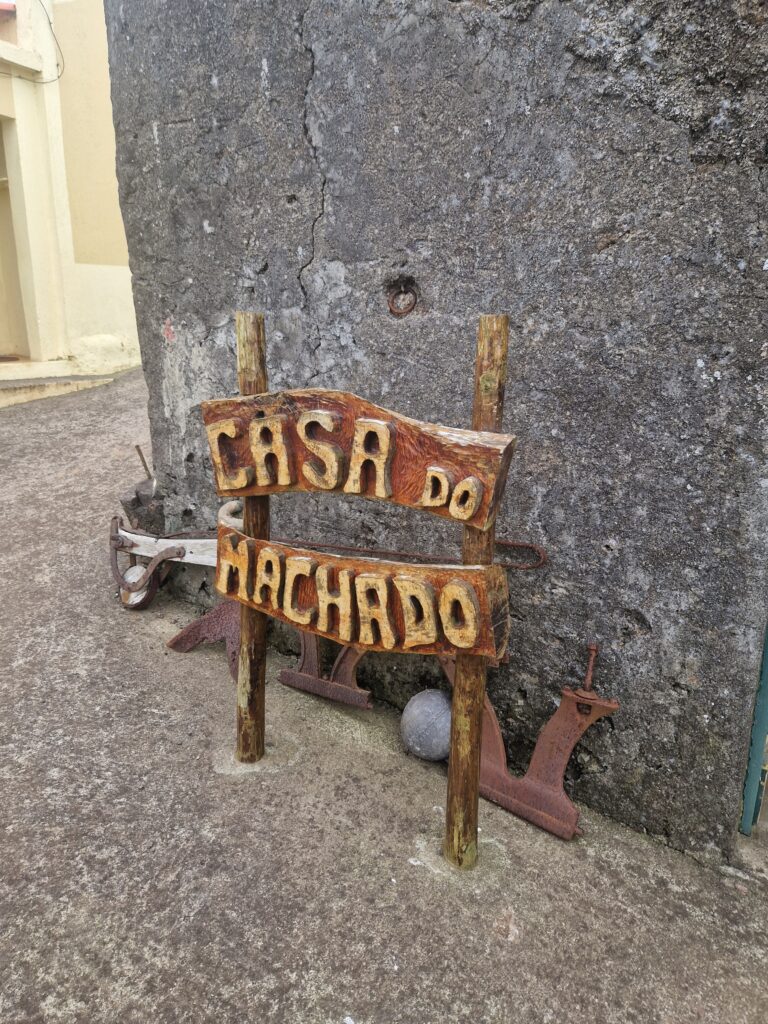
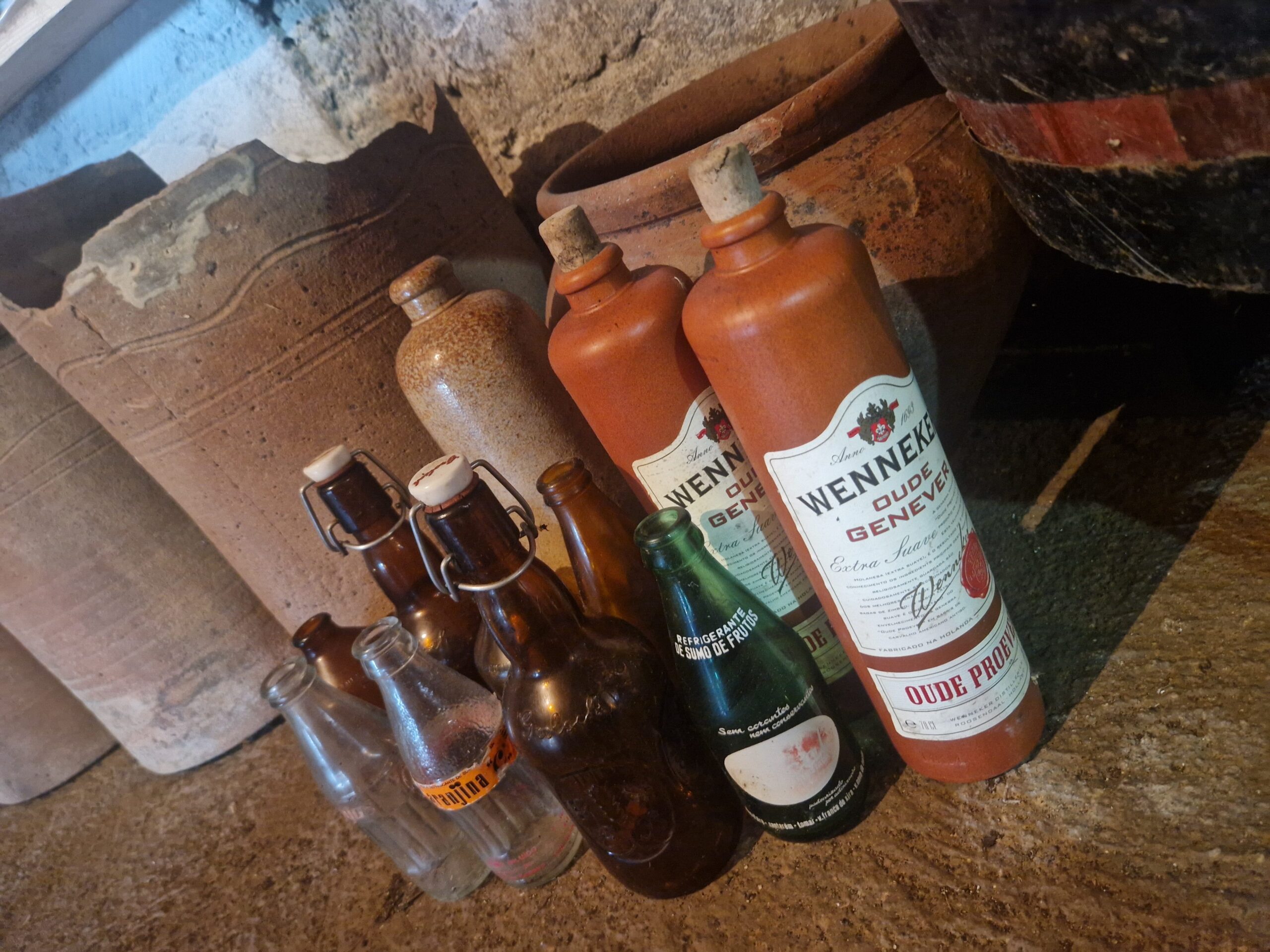
Our last stop was Miradouro do Ilhéu Furado – this viewpoint was in the clouds by the time we got there! I believe that Ilhéu Furado translates to ‘punctured islet’ which makes sense when you see it! From here we also saw the dramatic almost impossibly steep cliffs, Ilhéu de Álvaro Rodrigues and distant views of Santa Crus Das Flores.
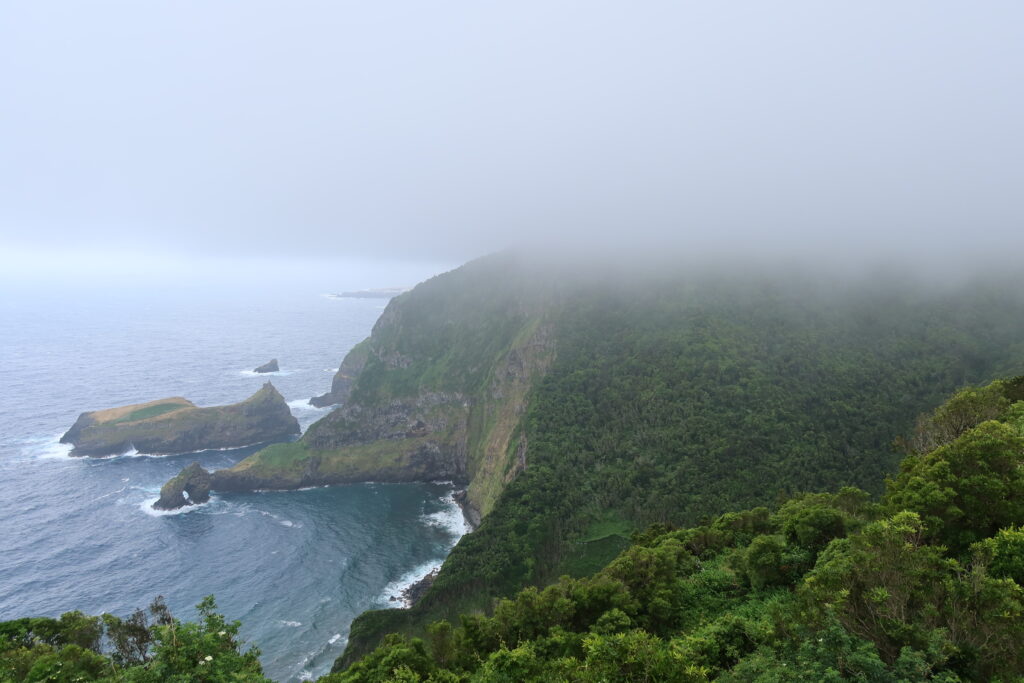
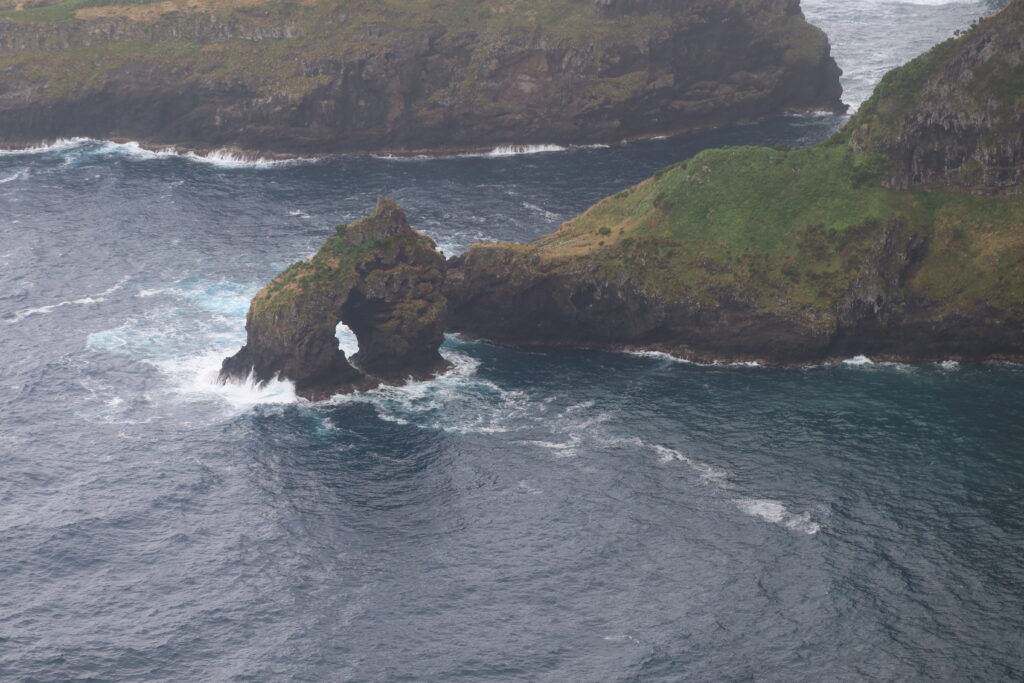
We arrived back to Fajã Grande to explore some more of the seemingly never-ending lava field. This time with the intention of getting a closer look at a fisherman. I wished I’d had space to pack a rod and reel so this was a chance to live vicariously through someone else fishing. In reality it felt like we walked for ages across the jagged lava and didn’t get anywhere near, finally seeing him as he packed up and was heading back!!
Dinner tonight was at Maresia Restaurante, we had walked down and booked a table the afternoon before to make sure we didn’t miss out. This tiny place only had 4 tables inside – it was amazingly personal. The constantly changing menu was handwritten and entirely led by what was available on the day. We ate deliciously fresh food while listening to music on the record player. The music itself was a story. The records themselves came via mainland Portugal and we were actually treated to first listens of some new arrivals. The owner’s dog was great company during dinner (100% our choice – he was really well trained and only came when called over).
The experience felt like we were part of the family for a couple of hours – it was lovely. After the meal we stayed for a few really nice g&ts while listening to music recorded by the owner’s son. He was an aspiring musician and was in the process of releasing his first album. (Funnily enough his target audience at first was Cape Verde – somewhere close to our hearts!)
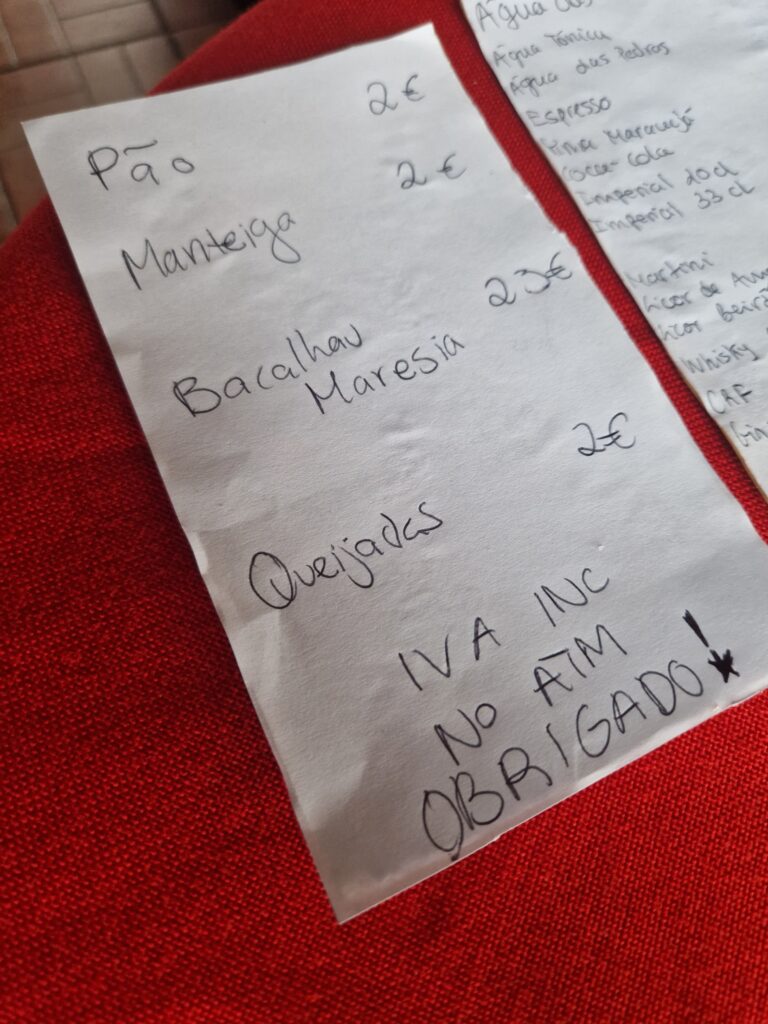
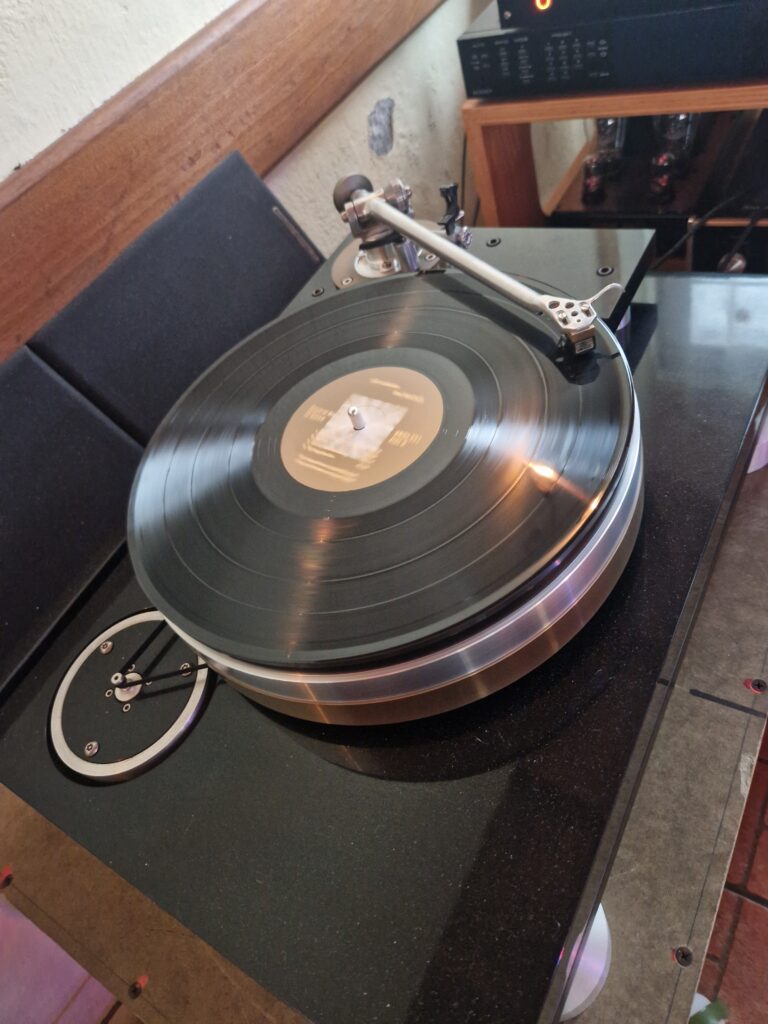
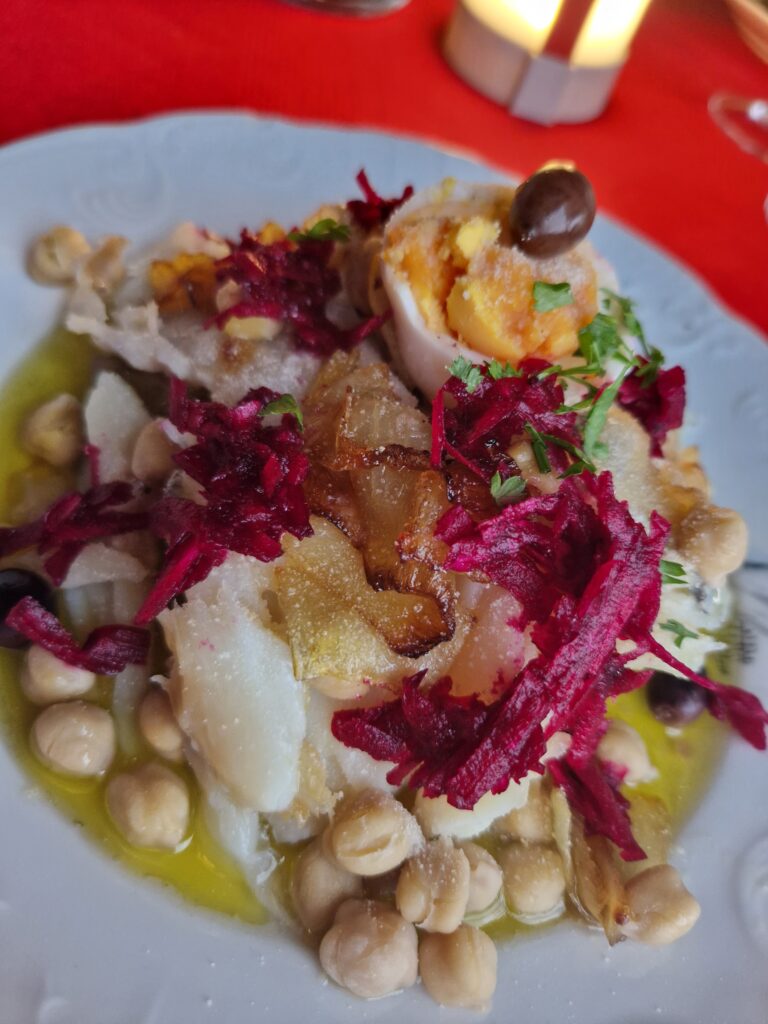
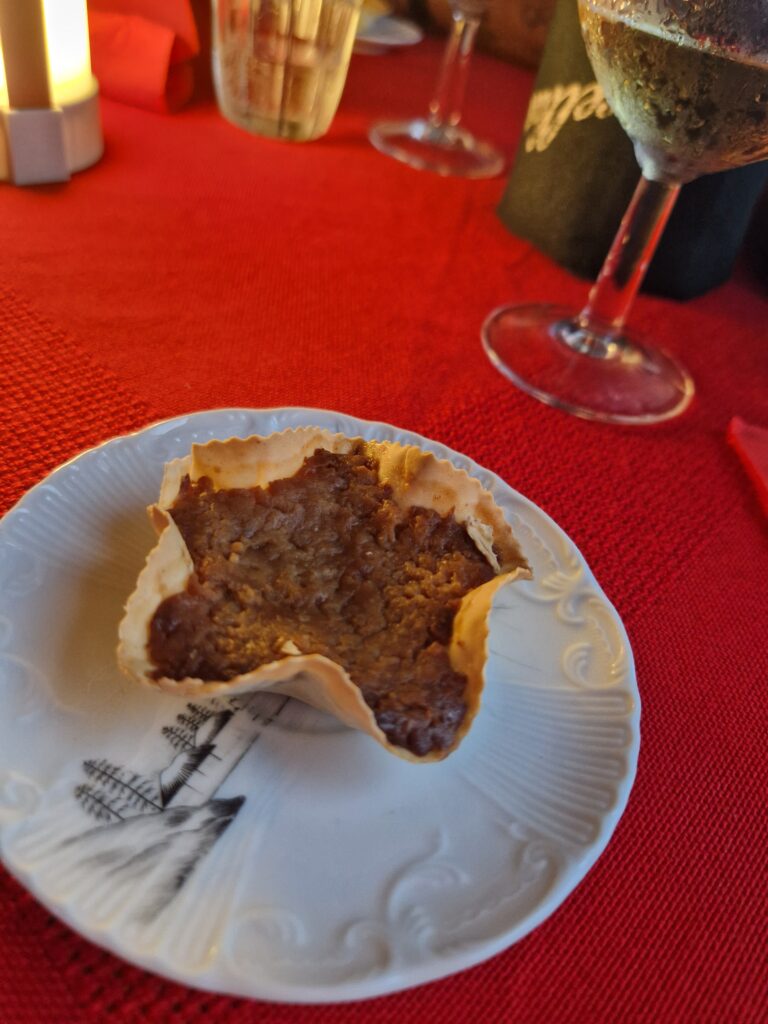

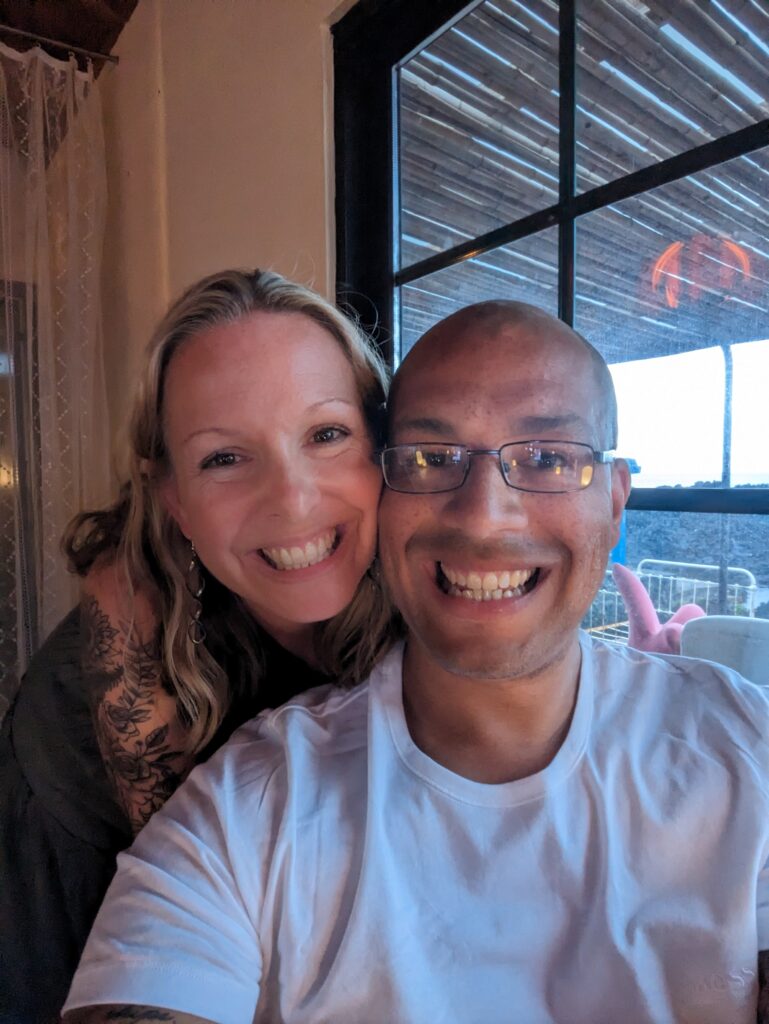
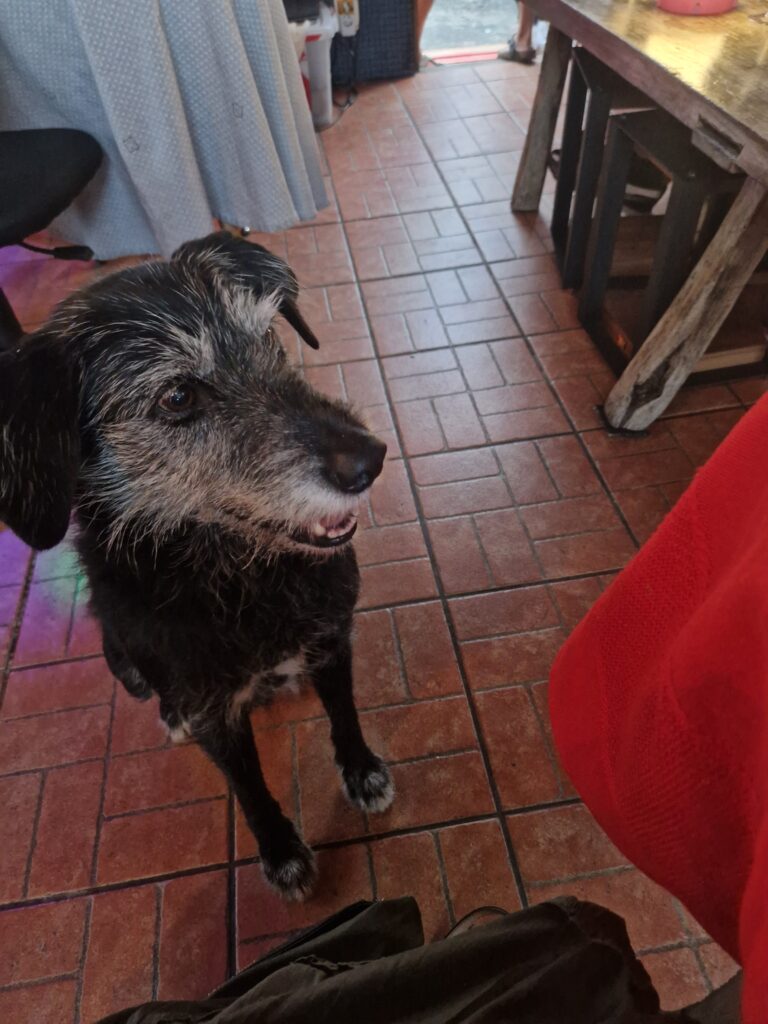
day 7 – should have been Corvo!
Today we should have been on a trip to Corvo but this was cancelled due to the weather.
Instead of taking us to the harbour for the boat to Corvo, the transfer minibus dropped us just outside the village of Mosteiro. With a population of 19 people, Mosteiro was originally populated by people fleeing a volcanic eruption at Ponta da Ferraria, Sao Miguel, where we were a couple of days ago. From here we walked following the coast back towards Fajã Grande.
The weather was ok where we were on the whole. There was a bit of rain and was quite windy at first but this soon died down. The path was so steep and some of it was quite slippery underfoot. The ascents got the heart pumping through exertion and the descents did too through worry of slipping.
There were stunning views from miradouros all the way along. These were not only great photo opportunities, but they were also great for a pause to catch our breath! We passed through the abandoned village of Caldeira do Mosteiro. This was deserted in 1992 and is slowly being taken over by nature. There are plans for an eco-resort here which would be amazing if it ever comes to fruition. It’s a pretty idyllic setting, in an ancient caldera with a stream running through the middle. It’s definitely isolated, I hope that the isolation (which would be the main draw) doesn’t spell the end of the proposed project like it did for the village all those years ago.
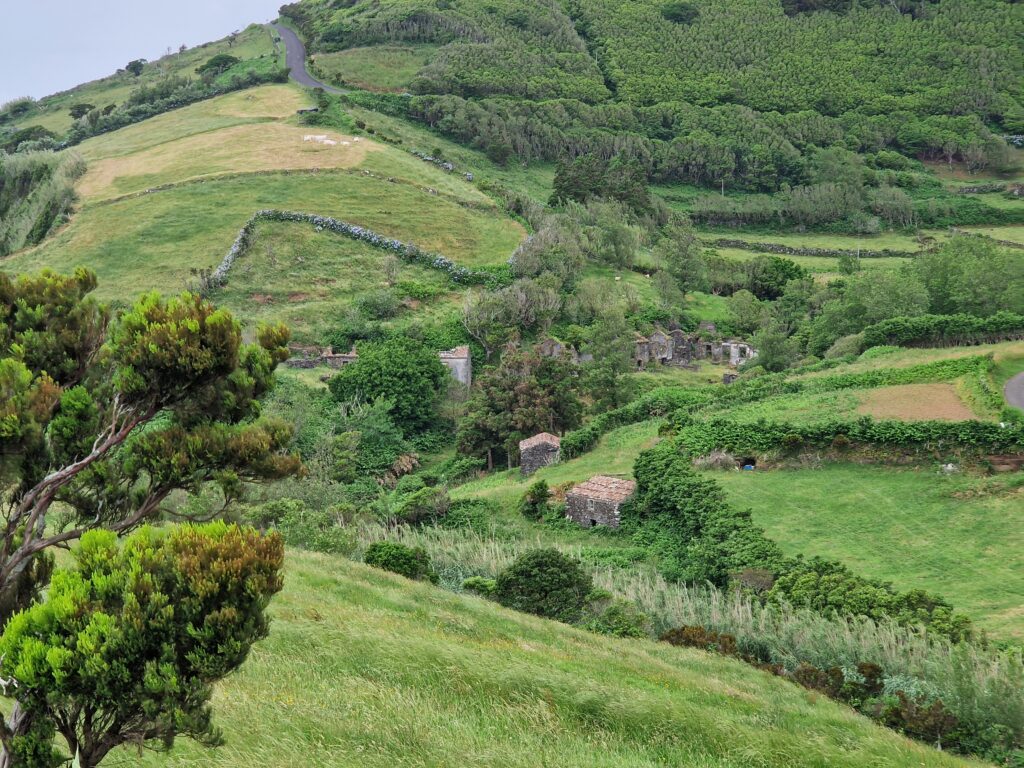
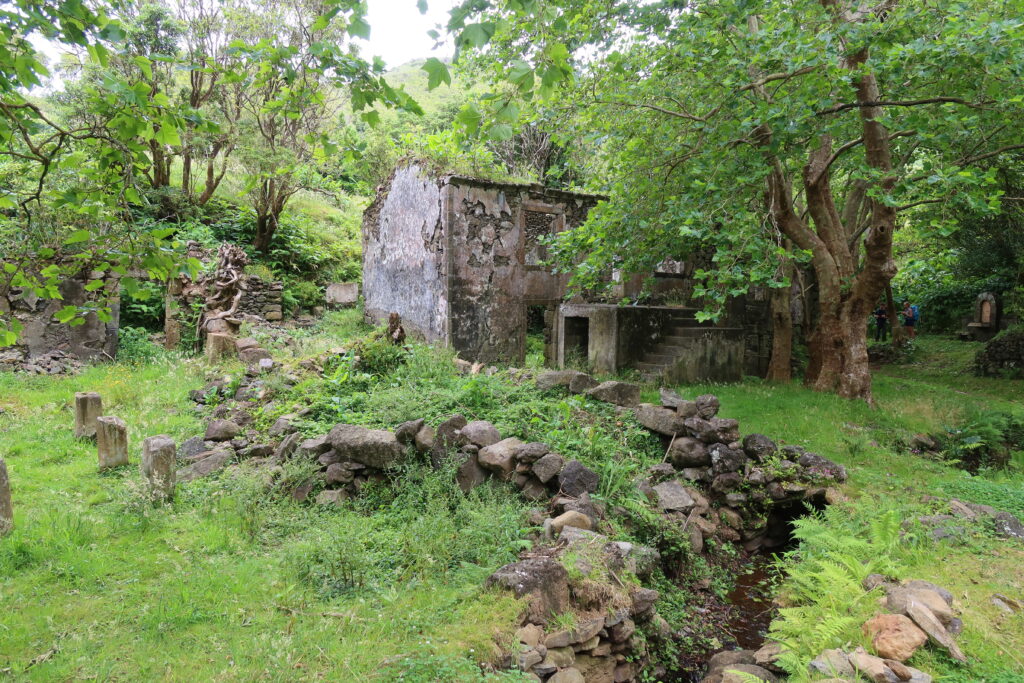
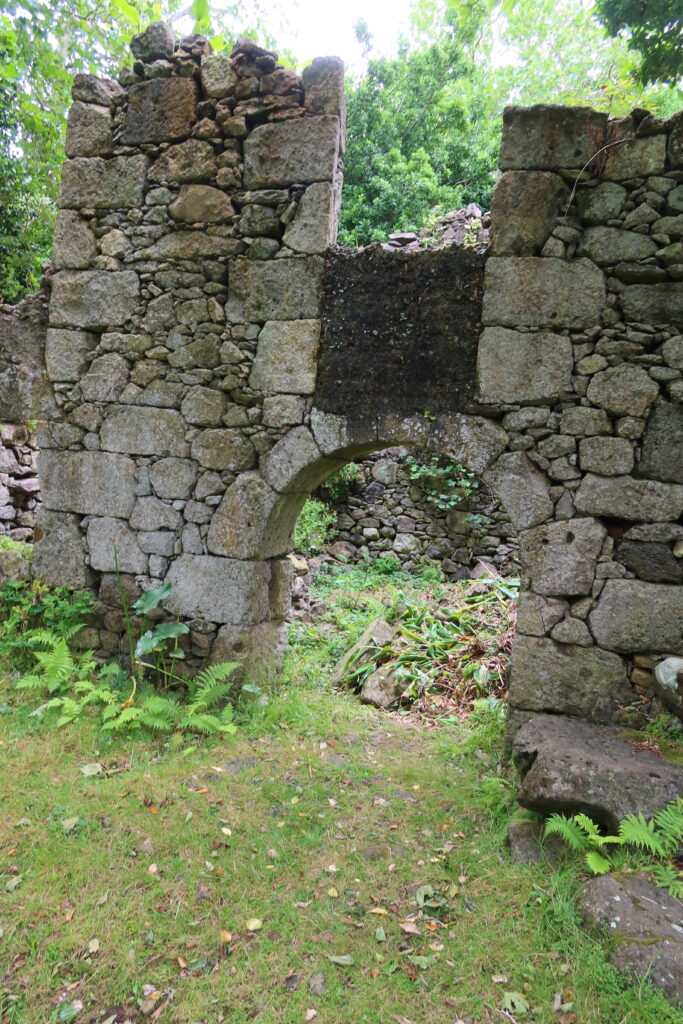
We continued to follow the coast path to Fajãzinha where we stopped for lunch. We ate at Restaurante Pôr-do-Sol (the only restaurant in the village of 71 people). The food was basic but really tasty. In order to avoid language issues there was a single sheet printout of the menu in English and Portuguese which one would tick to mark what was wanted. This system worked perfectly and seemed a really good idea for a tiny village where only a handful of people visit.
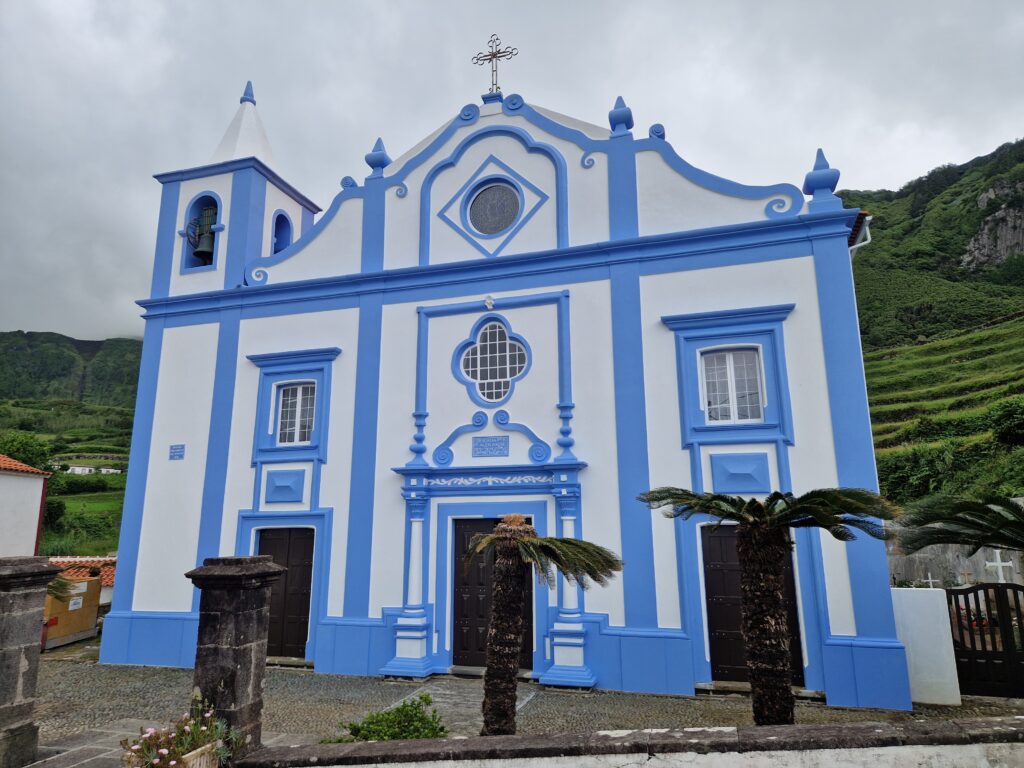
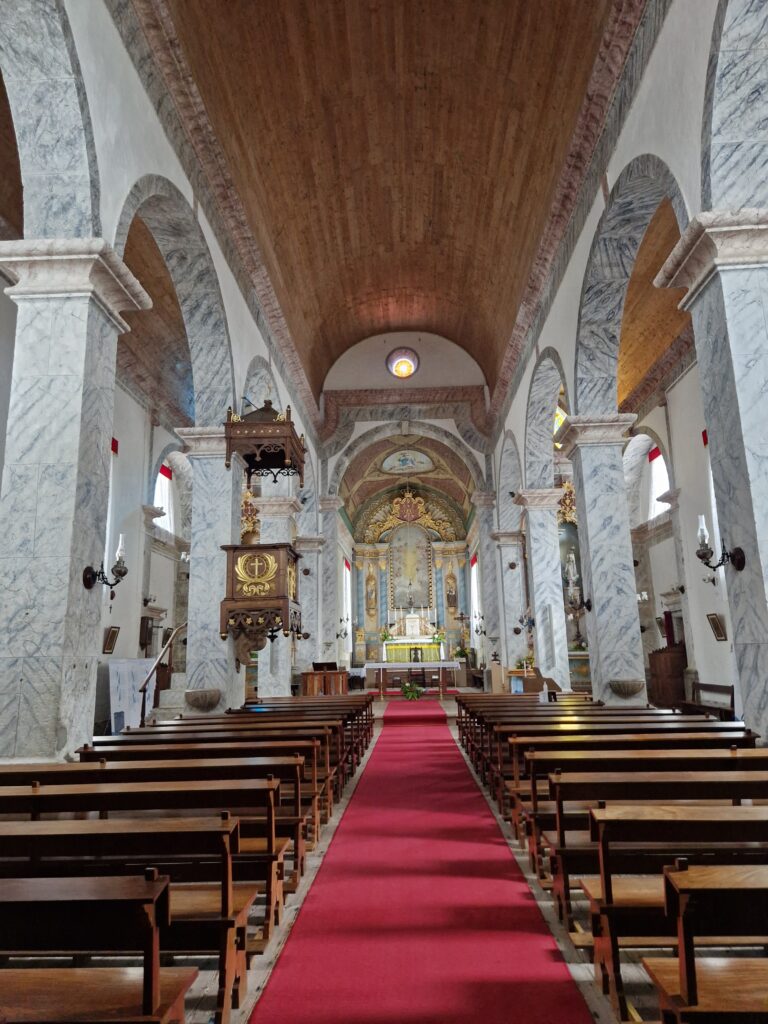

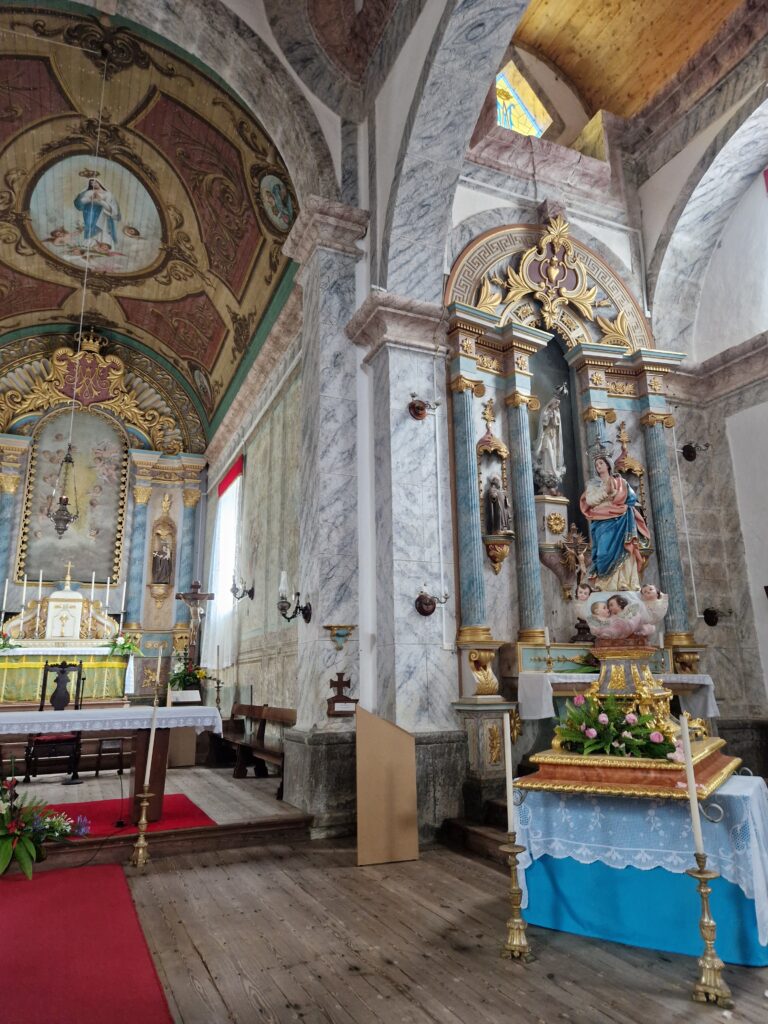
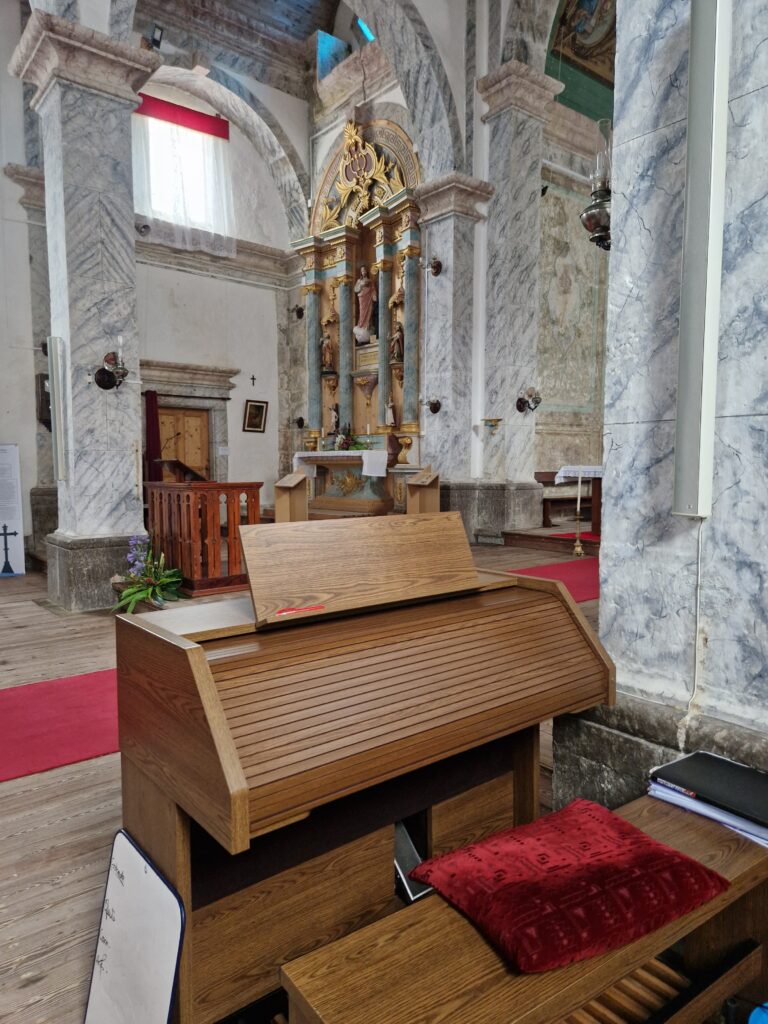
After lunch we continued walking, crossing a very rudimentary bridge before deciding to explore Ribeira Grande. We scrambled upstream as far as we could until the water got too deep/fast moving to be able to cross it anymore. It was like our own ‘budget version’ of canyoning, without any of the safety equipment (or skill!!).
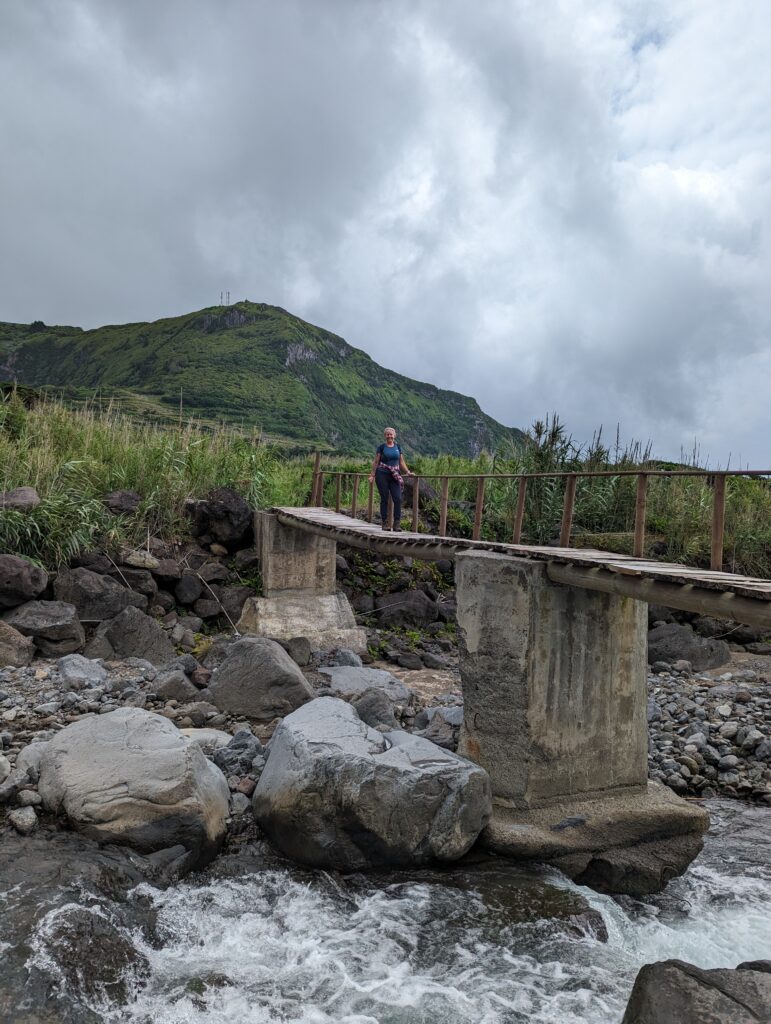
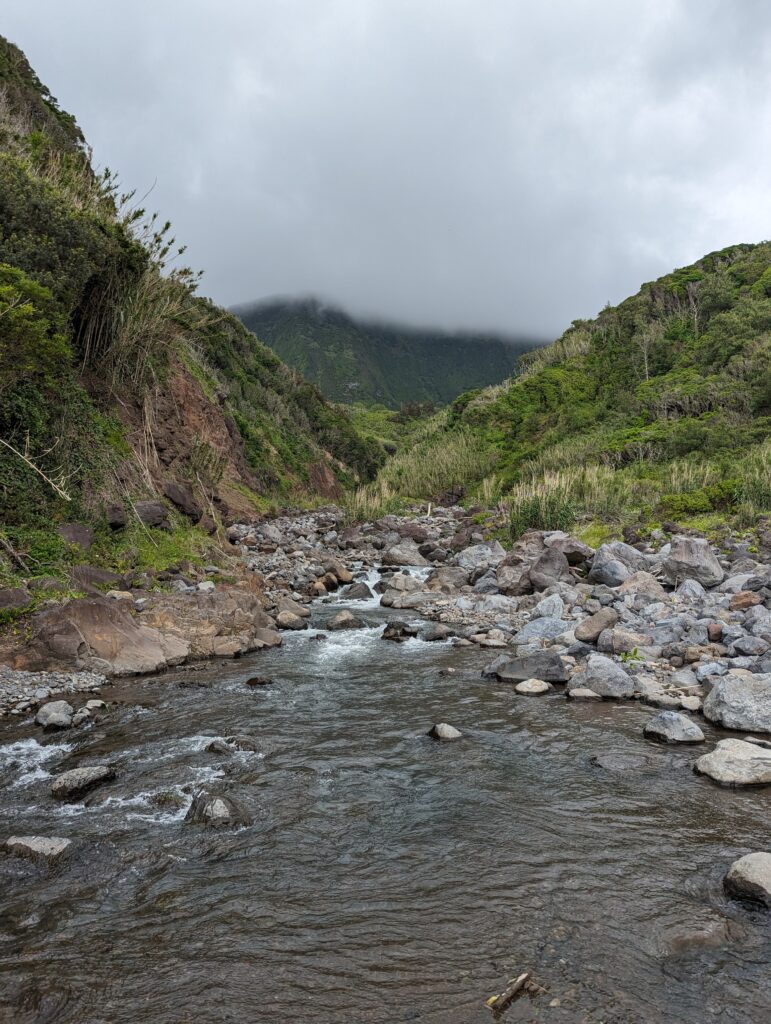
We continued on the coastal path to Fajã Grande, taking in more amazing views. The coastline really was stunning, and everything around us was so unspoilt.
Upon arriving in Fajã Grande we went back to guest house to start packing. This evening we had dinner at Papadiamandis Restaurante-Bar again.
day 8 – Flores
We enjoyed our final breakfast made by Stefano then set off for a walk along the coastal path north from Fajã Grande. The walk was just amazing…there were more incredible views, waterfalls tumbling off the cliffs and just so much life everywhere.
We walked past Igreja de Nossa Senhora Do Carmo and up the steep cliffs for a brief clifftop walk before heading back to the village. While there weren’t many people around, everyone we did see was so welcoming and seemed genuinely pleased to see us exploring their island.
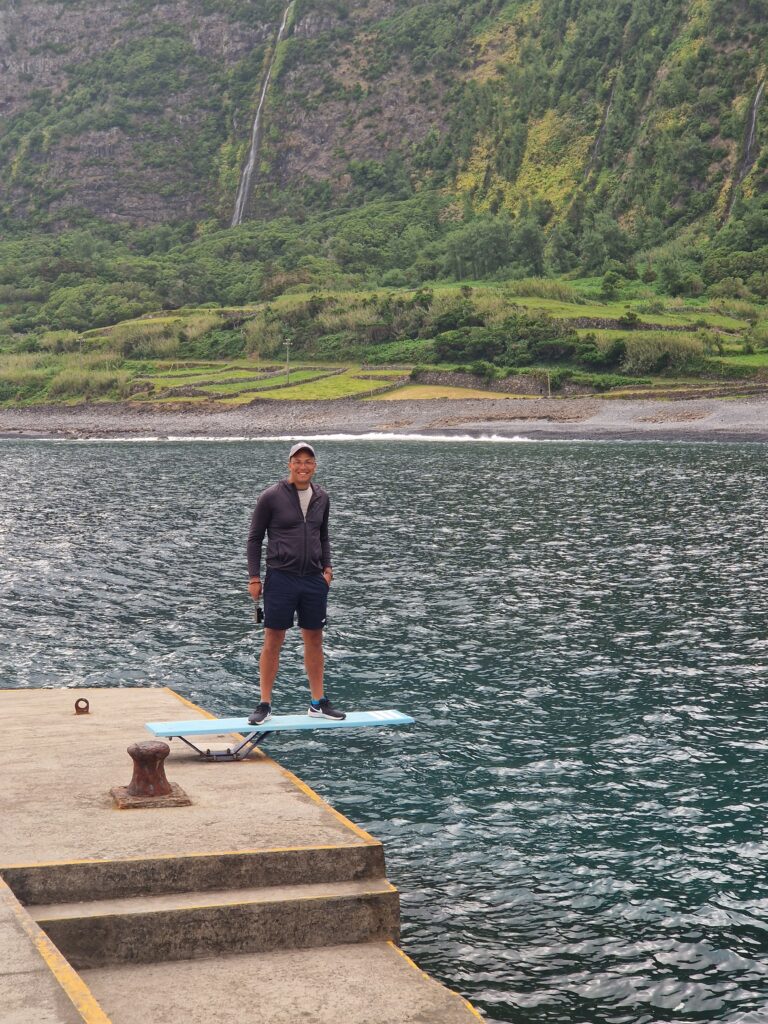
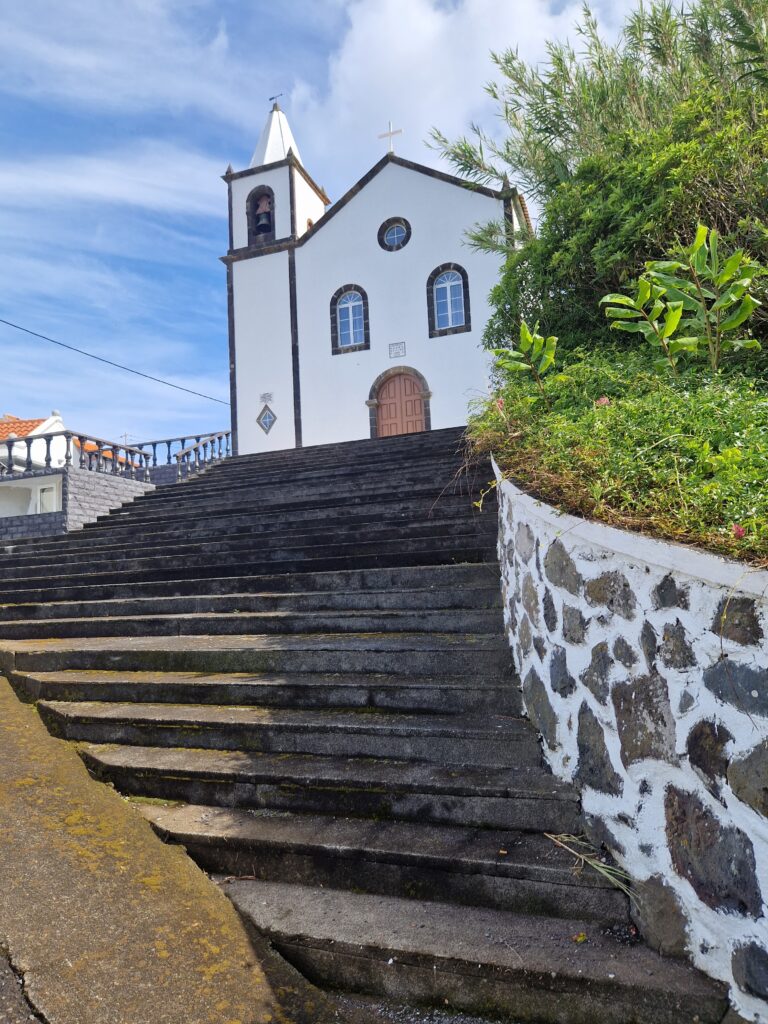
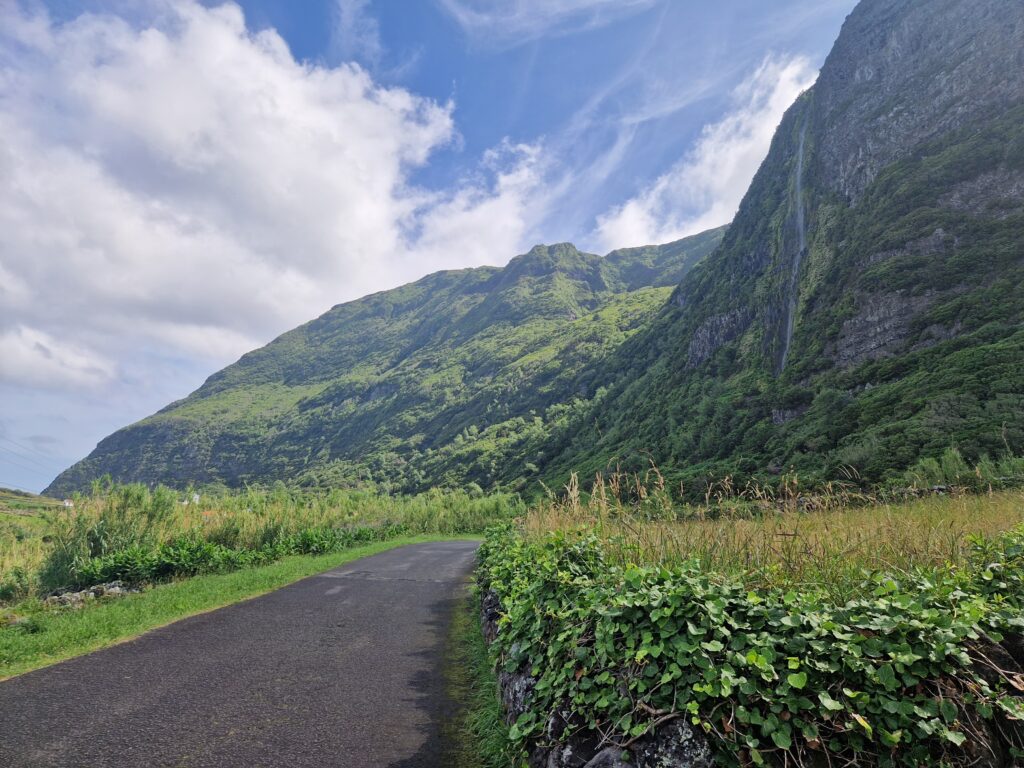
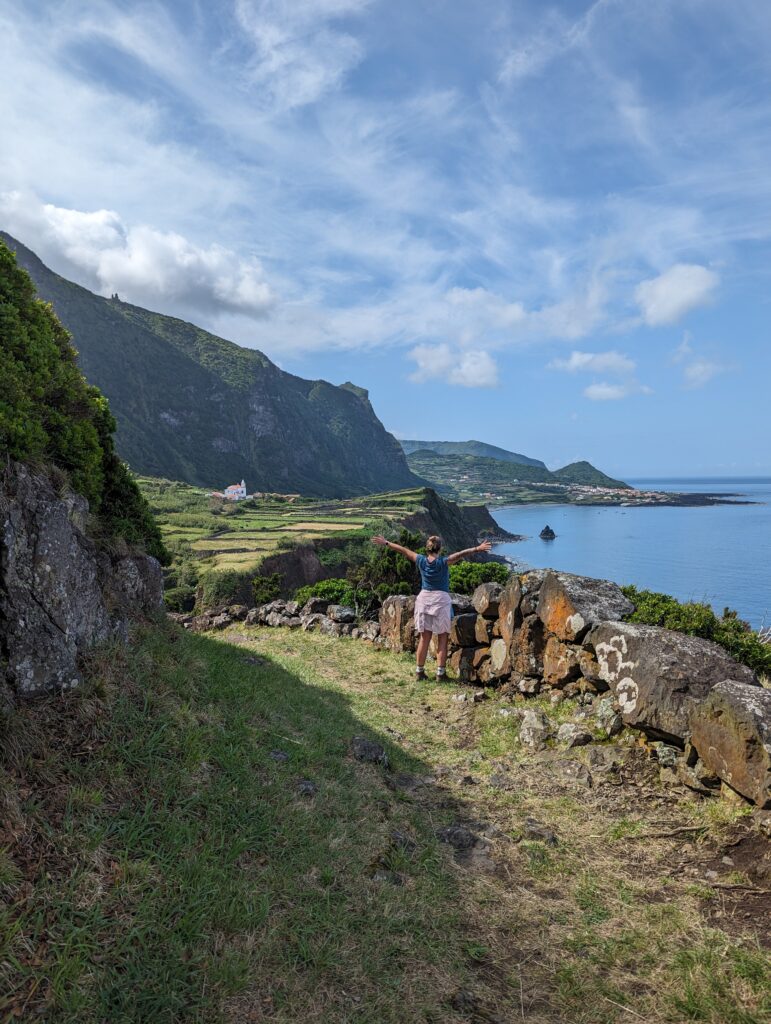
We got back to the guest house to check out and Stefano signed a copy of his book for us. This book is about his visit to Maha Kumbh at Prayagraj, India. It’s the largest gathering of people in the world with up to 120 million people making the pilgrimage there over the duration of the event, with up to 40 million attending on a single day! We loaded everything into his car and took us across the island to the airport.
On the way to the airport Stefano insisted that we stop to make face imprints in the moss covering rocks on the side of the road. The moss was so thick and soft, and our faces really did leave an imprint in it temporarily!
We’d had notification that our flight had been cancelled while at the guest house. Archipelago Choice advised that it was likely to be just a reallocation of flight number. This was the case so we checked in, dropped our baggage off and set out to explore Santa Crus Das Flores while waiting for the flight. It was, as you’d imagine given the size of Flores, a tiny town – total population was around 2000 people. We saw distant views of Corvo as well as Igreja Matriz de Santa Cruz das Flores (an impressive church).
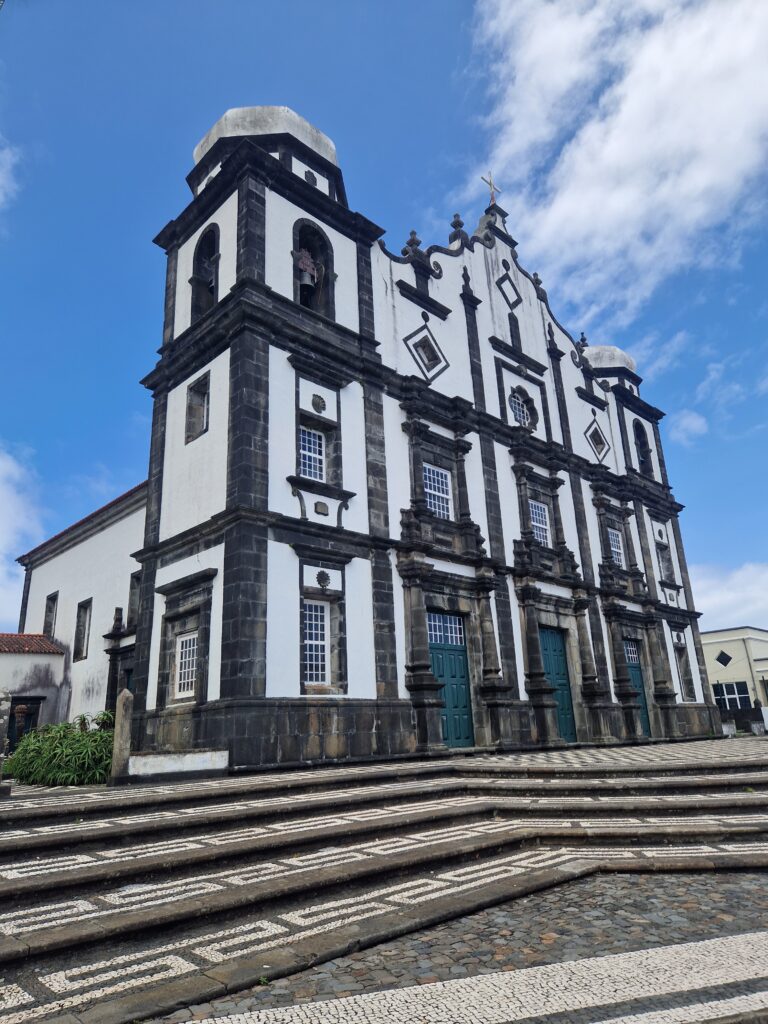
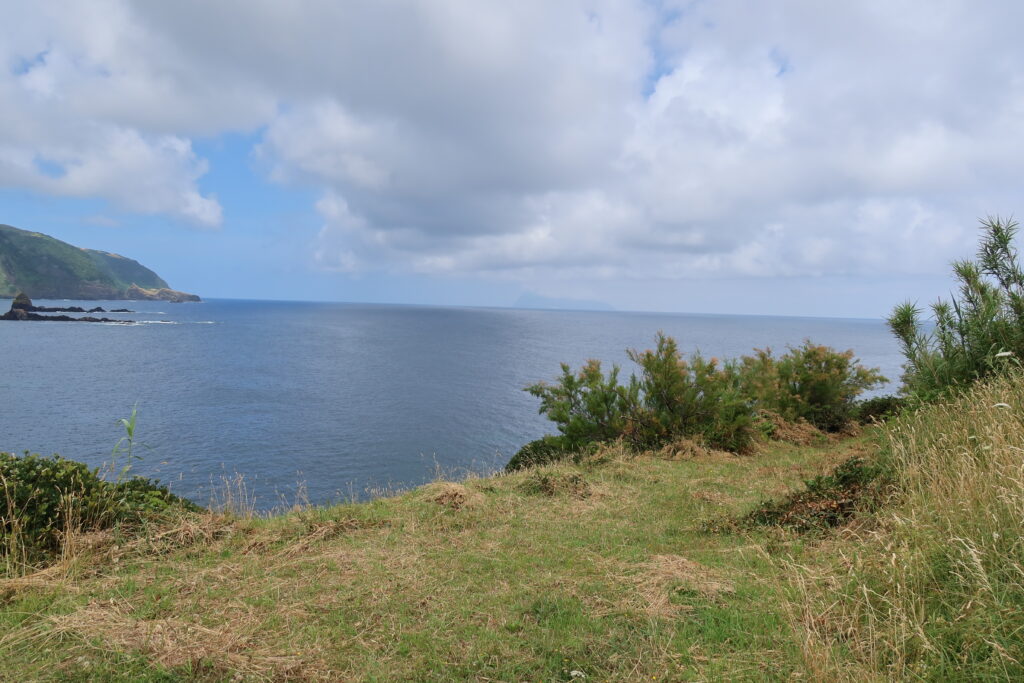
After a bit of a walk we headed back to the airport. The planes had been getting progressively smaller and this one was the smallest yet, a Bombardier Q200. We were in row 9 which was the very back of the plane! With the crew there were a total of 40 people on the flight.
Next up are Faial and Pico – read about them here.

